|
| |

Adromischus cristatus
Aeonium Aloes Agave Aptenia Bryophyllum
Carpobrotus Crassula Delosperma
Disphyma Drosanthemum Echeveria Faucaria
Rebutia Graptopetalum Haworthia Kalanchoe Lampranthus Portulacaria Sedum Senecio
Adromischus
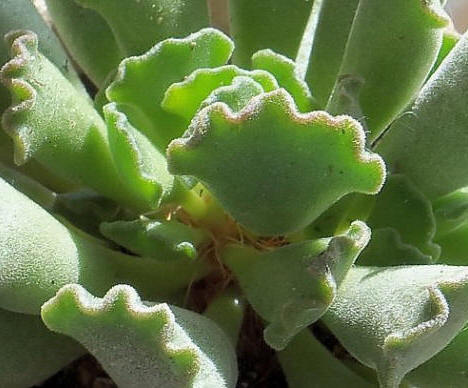
Adromischus cristatus
Endemic to the eastern
cape of South Africa. It is a perennial with short erect branches
20–50 mm long covered with fine aerial roots. Leaves are green to
grey-green, with undulating margin, and generally measuring 20-40
x 5–13 mm. During the springtime, it sends up long narrow stalks
for its flowers, which are tubular in shape and white in color
with hints of red. Common names for this plant include "Key Lime
Pie" and "Crinkle Leaf Plant." |
| |
|
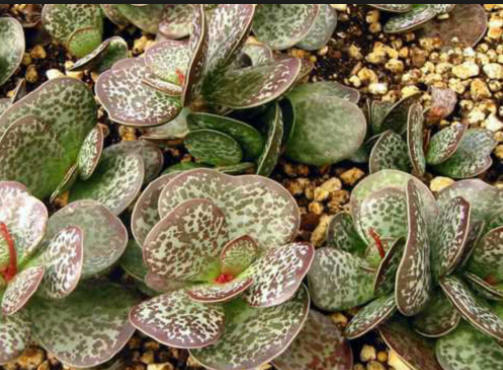
Adromischus maculatus:
Small,
flat grey-green leaves heavily blotched with deep crimson.
Clumping succulent rosettes. Part shade. Tender soft succulent -
will not tolerate frost. |
| |
|
| |
|
|
|
|
|
Aeonium (tree houseleek) is a genus of about 35 species of
succulent, subtropical plants of the family Crassulaceae. The name
comes from the ancient Greek "aionos" (ageless).
While most of
them are native to the Canary Islands, some are found in Madeira,
Morocco.
The rosette leaves are on a basal stem. Low-growing Aeonium
species are A. tabuliforme and A. smithii; large species include
A. arboreum, A. valverdense and A. holochrysum.
Aeonium are not frost-resistant. Aeoniums require little water
(irrigation every 15 days) and in winter watering can be reduced
to up to two months to survive cold conditions. It needs sun or
partial shade. In general the green aeoniums prefer some shade -
the purple ones like full sun. They will not withstand frost and
extreme temperatures. In the summer they must be outside for good
growth, The aeonium does not require a particular soil but
it must be free draining. In sandy soils compacted plant grows
best. It grows well in direct ground or in pots. When the plant is
located directly on the ground the plants need shelter from the
direct sun (especially if they have been indoors for the winter)
and frost or low winter temperatures.
|
|
 Aeonium
arboreum
Aeonium arboreum, (syn.
Sempervivum arboreum), the tree aeonium, tree houseleek, or Irish
rose, is a succulent, subtropical subshrub of the genus Aeonium.
It is native to the hillsides of the Canary Islands.
It bears
rosettes of leaves and large pyramidal panicles of bright yellow
flowers in the spring
It needs to be grown under glass.
The purple
form 'Zwartkop' ('Schwartzkopf') has gained the Royal
Horticultural Society's Award of Garden Merit.
There is also a
white variety (var. albovariegatum). |

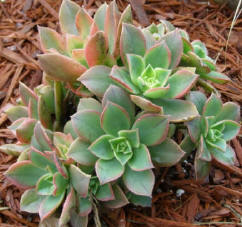
aeonium
kiwi
Aeonium 'Kiwi'
is a highly attractive tender plant that forms rosettes of fleshy
leaves with a brilliant colour.
They are yellow in the centre,
turning green progressively towards the outside of the rosette.
This delightful plant also has red edges to the leaves. The succulent develops
yellow flowers in the summer once established. |
| |
|
|

Aeonium decorum tricolor
A lovely branching plant
,with bright red /pink leaves
variegated with yellow
grows as a bush 35cm hig flowers are best pruned off as they grow
badly after flowering .good to -1
|
| |
|
|
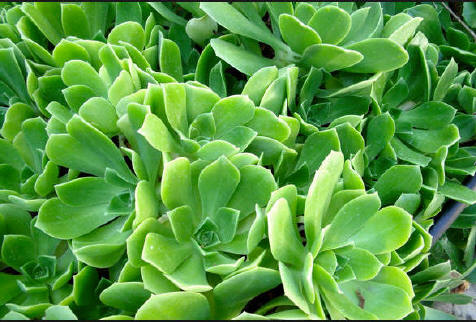 Aeonium
undulatum,
A succulent, evergreen
subshrub, is one of the larger species of aeonium with the rosette
often over a metre from the ground on a single stem.
Other
rosettes do not branch off this stem (normally) but grow from the
bottom, unlike most aeoniums.
The plant is monocarpic so the
flowering stem will die when it flowers which is normally after
about 5 years.
The specific epithet undulatum comes from the Latin unda, meaning
"wave" and refers to the wavy leaves.
The common name "saucer
plant" is applied to this and other plants of a similar habit.
In temperate regions this plant is grown under glass.
It has gained the Royal
Horticultural Society's Award
of Garden Merit.
|
| |
|
|
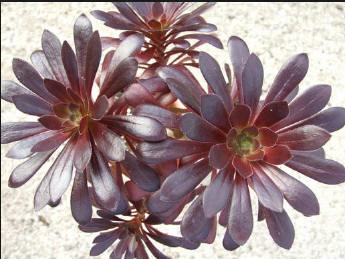 Aeonium
arboreum 'Schwarzkopff'
A
purple succulent
A much sought after deep purple (almost black) perennial succulent
(height 60cm/1.9ft, spread 90cm/3ft) that brings colour to the
garden all year round with several stems bearing rosettes of
foliage, and gold yellow flowers on mature plants in the spring .
A
neat, slow growing specimen for a water deficient spot or pot -it
should be planted in sun or light shade in a very well drained
soil, and should be protected from frost.
|
| |
|
|
 Aeonium
Sunburst
A beautiful variegated Aeonium
A variegated cultivar
differing from tricolour in that the leaves are narrower, flatter
and less incurved,
A beautiful
succulent (max height 80cm/2.6ft, max spread 60cm/1.9ft) with
green,
yellow and pink
tipped leaves. This stunning variegation is joined by white/yellow
flowers
in April and
May for even more interest.
It will grow
best in a bright room, greenhouse or very warm, sheltered sunny
position
i.e. with
some direct sunlight. It should be protected from frosts/the
coldest temperatures-1.
|
Aloes

is a genus containing over 500 species of flowering succulent
plants. The most widely known species is Aloe vera, or "true
aloe", so called
because it is cultivated as the standard source
of so-called "aloe Vera" for assorted pharmaceutical purposes
there are many other species |
| |
|
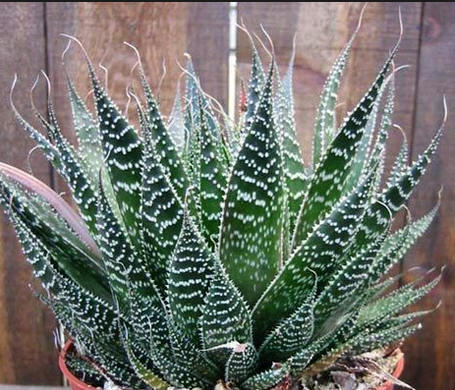 Aloe
aristata
Torch Plant and Lace Aloe.
An evergreen perennial, forming rosettes of fleshy lance-shaped
leaves spotted with white and tipped with a soft white spine.
Tubular, orange-red flowers in
autumn.
Ideal Conditions: Prefers full sun, or partial shade with moist
soil or compost.
:Perfectly suited
for planting in gravel gardens, paved areas, rockeries and small
containers.
Try mixing with other
succulents and alpines.
|
| |
|
|

Aloe vera
An evergreen perennial, it originates from the Arabian Peninsula
but grows wild in tropical climates around the world and is
cultivated for agricultural and medicinal uses.
The species is also used for decorative purposes and grows successfully indoors
as a potted plant.
It is found in many consumer products including beverages, skin
lotion, cosmetics, or ointments for minor burns and sunburns.
Aloe vera is a stemless or very short-stemmed plant growing to
60–100 cm (24–39 in) tall, spreading by offsets.
The leaves are
thick and fleshy, green to grey-green, with some varieties showing
white flecks on their upper and lower stem surfaces. The margin of
the leaf is serrated and has small white teeth. The flowers are
produced in summer on a spike up to 90 cm (35 in) tall, each
flower being pendulous, with a yellow tubular corolla 2–3 cm
(0.8–1.2 in) long
|
| |
|
|
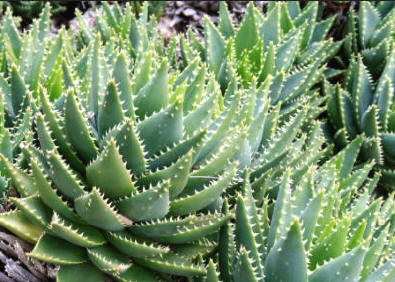
Aloe brevifolia
(Kleinaalwyn, short-leaved aloe) is a species of flowering plant
in the family Asphodelaceae.
It is a tiny, compact, blue-green
evergreen succulent perennial, that is native to the Western Cape,
South Africa. Listed as Vulnerable on IUCN's global Red List, it
is threatened in its natural habitat, |
| |
|
| |
|
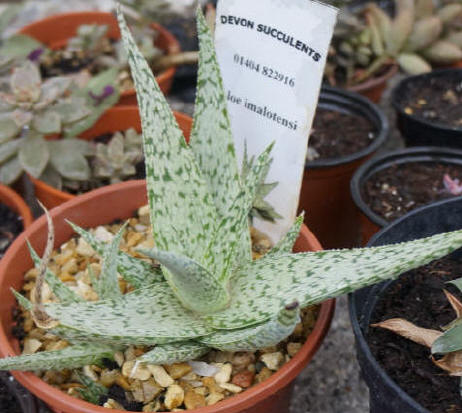
Aloe
imalotensi
Most Aloe species have a rosette of large, thick, fleshy leaves.
Aloe flowers are tubular, frequently yellow, orange, pink, or red,
and are borne, densely clustered and pendant, at the apex of
simple or branched, leafless stems.
Many species of Aloe appear to
be stemless, with the rosette growing directly at ground level; other varieties may have a branched or unbranched
stem from which the fleshy leaves spring.
They vary in colour from grey to
bright-green and are sometimes striped or mottled. . The
succulent stems cope well with dry positions. |
| |
|
| |
|
|
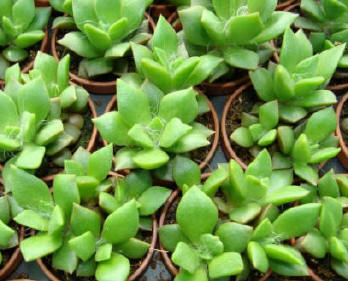

Anacampseros rufescens
is a small, perennial succulent plant with olive green, narrow,
pointed leaves arranged in a spiraling
rosette. In shaded or partially shaded positions the leaves
are olive green in colour while in sunlight the leaves are a dark
reddish-brown to purple.
As the plant matures and produces more rosettes, |
|

is a genus of monocots native to the hot
and arid regions of Mexico and the southern United States.
Some agaves are also native to tropical
areas of South America. The plants are perennial, but each rosette
flowers once and then dies . Some species are known by the name
century plant
|
|

Agave americana, century plant,
was introduced into southern Europe about the middle of the 16th
century, and is now widely cultivated as an ornamental, as it is
in the Americas. In the variegated forms, the leaf has a white or
yellow marginal or central stripe. As the leaves unfold from the
center of the rosette, the impression of the marginal spines is
conspicuous on the still erect younger leaves. The plants require
protection from frost. They mature very slowly and die after
flowering, but are easily propagated by the offsets from the base
of the stem.Agave
tequilana
(agave azul or blue agave)
is used in the production of tequila.
Agave nectar (also called
agave syrup), a sweetener derived from the sap, is used as
Each rosette is monocarpic and grows slowly to flower only once.
During flowering, a tall stem After development of
fruit, the original plant dies,but suckers are frequently produced
from the base of the stem, which become new plants.
It is a common misconception that agaves are cacti. They are not
related to cacti, nor are they closely related to Aloe whose
leaves are similar in appearance.
Agave species are used as food plants by the larvae of some
Lepidoptera (butterfly and moth) The leaves also have sharp,
spiked edges. The spikes discourage predators from eating the plant or
using it as a source of water and are so tough that ancient
peoples used them for sewing needles. The sap is acidic. Agaves
bloom at a height up to 30 ft (9 m) |
|
|
|
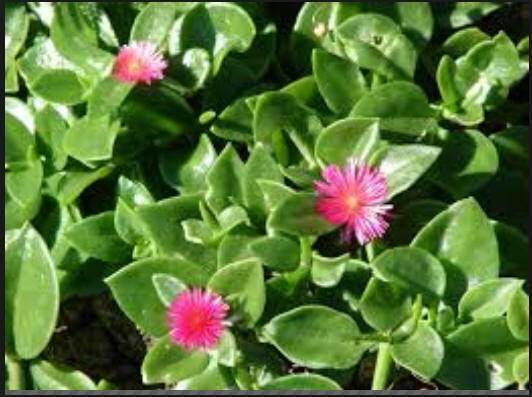
Aptenia
'Red Apple
is a species of succulent
plant in the iceplant family known
by the common names heartleaf iceplant[ and baby sun rose.
Perhaps the most common
plant seen under this name is actually Aptenia 'Red Apple', a
hybrid with red flowers and bright green leaves, whose parents are
A. cordifolia and A. (Platythyra) haeckeliana.
This is a mat-forming perennial herb growing in flat clumps on the
ground from a woody base. Stems reach up to about 60 centimeters
long. The bright green leaves are generally heart-shaped and up to
3 centimeters long. They are covered in very fine bumps. Bright
pink to purplish flowers appear in the leaf axils and are open
during the day. The fruit is a capsule just over a centimeter
long. |
| |
apt pink to do |
| |
|
|

|
| |
|
|
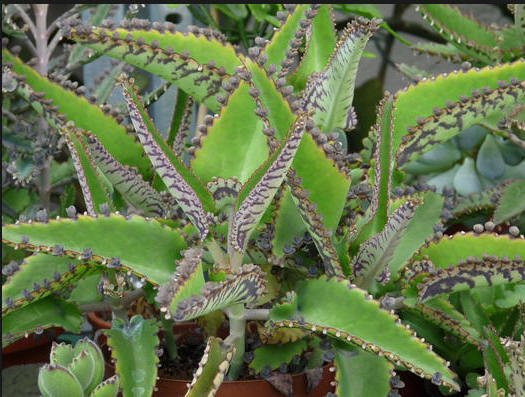 Bryophyllum
daigremontianum,
also called mother-of-millions,
mother-of-thousands, alligator plant, or Mexican hat plant is a
succulent plant native to Madagascar. Like other members of its
genus Bryophyllum, it is able to propagate vegetatively from
plantlets that develop on its phylloclade margins. All parts of
the plant are poisonous (they contain daigremontianin and other
bufadienolides), which can even be fatal if ingested by infants or
small pets. ]Bryophyllum daigremontianum has an umbrella-like
terminal inflorescence (a compound cyme) of small bell-shaped,
grayish pink (or sometimes orange) flowers. Flowering is, however,
not an annual event and occurs sporadically if at all on some
shoots.
As a succulent plant, B. daigremontianum can survive prolonged
periods of drought with little or no water. It is however not
frost-hardy and typically dies if subjected to temperatures below
freezing. |
| |
|
|
 |
|
|
 Carpobrotus edulis
is native to South Africa. It is also
known as Hottentot-fig, ice plant, highway ice plant or pigface
and in South Africa as the sour fig (suurvy; earlier: hotnotsvy),
on account of its edible fruit.
It was previously classified in genus Mesembryanthemum and is
sometimes referred to by this name.
used to make a type of soap. |
| |
|
| |
|
|

Ceropegia woodii f. variegata
Common Names include:
ENGLISH: Rosary
Vine, String of hearts, Chinese Lantern, Hearts-on-a-string,
Sweetheart vine, Keepsake Heart, Chain of Hearts, Heart Strings,
Collar of Hearts
Description: Succulent, evergreen trailing vine, that
grows to 2-5 cm in height and spreads to reach up to 2-4 m in
length.
Stem: Thin and pendulous from which leaves hang,
Leaves: Heart shaped that look somewhat like cyclamen
leaves and marbled with shades of silver and green on the top,
and green to purple on the undersurface. They are opposite
Tubers: The roots, and occasionally the stems, will often
develop tubers. On the stems these form at nodes and are likely
the reason for the common name of rosary vine. The tubers are
that forms at regular intervals on the stems can be used to
propagate the plant
|
| |
|
|
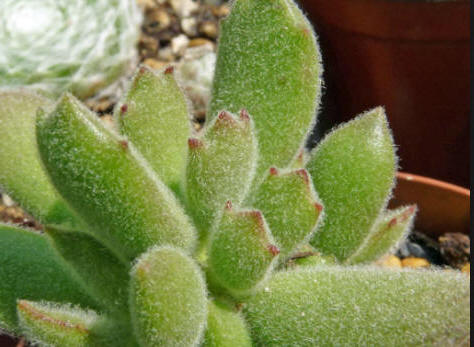 Cotyledon tomentosa
(Bear's
Paw)
is a species of
the Cotyledon genus.
Cotyledon tomentosa, native to Africa, has large chunky ovate
fuzzy green leaves with prominent "teeth" at tips that give the
impression of bear's paws. It forms large orange bell-shaped
flowers in spring. In habitat in Africa, Cotyledons usually grow
in rocky quartz fields where they have excellent drainage provided
by very porous soil. They thrive with bright light and ample
airflow. Water thoroughly when soil is dry to the touch. Water
with caution in winter, as the plant can lose its roots if the
soil stays cold and wet for extended periods. They are dormant in
summer. Protect from frost |
| |
|
|
Crassula
Crassula is a genus of
succulent plants containing about 1480 accepted species, including
the popular jade plant (Crassula ovata).
They are native to many
parts of the globe, but cultivated varieties originate almost
exclusively from species from the Eastern Cape of South Africa.Crassulas are usually propagated by stem or leaf cuttings. Most
cultivated forms will tolerate some small degree of frost, but
extremes of cold or heat will cause them to lose foliage and die.,
such as Aloe ferox, also are cultivated or harvested from the wild
for similar applications.
 |
|
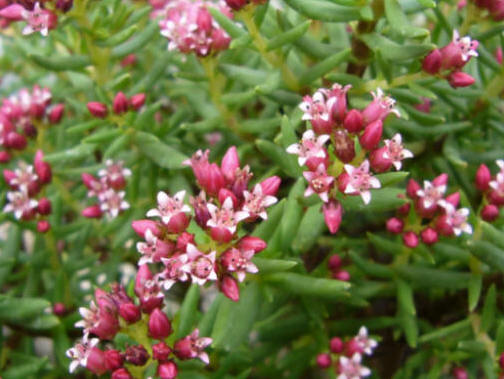 Crassula sarcocaulis
easy to grow, but they are susceptible to mealy bugs and fungal
diseases. As with all succulents, over watering is sure to be
fatal, so err on the side of too dry rather than too wet. Never
let your Crassula sit
in water. If you water from beneath by letting the plant sit in a
saucer of water, make sure to pour off any excess water after a
few minutes.
strange smell to the flowers
easy to Bonsai |
| |
|
|

Crassula perforate
The most important thing to
realise is not to give too much water, water every few days as
this can harm the plant, and it's not good for the shape of the
plant.
The plant will grow too fast and it will lose its beauty. When the
soil is too wet there is also the possibility that the roots will
rot. Let the soil dry out properly before you water it again. at
the end of October till the end of February there is so little
light that the plant hardly needs any water. Maybe once or twice
in this period you can put the plant on a dish with some water on
it, so that only the bottom part of the pot will absorb some
water. This should be sufficient.
Please do not water the plant as much as during the rest of the
year
|
| |
|
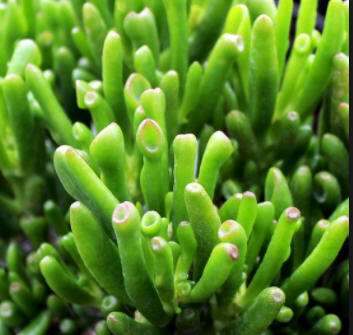 Crassula ovata
Gollum
'Gollum' Jade: Considered a monstrose or
mutated form of Jade. Tubular leaves have red tinged suction cup
like tips. Star shaped white flowers. Bright light to full sun.
Drought tolerant. Tender soft succulent - will not tolerate frost.
|
| |
|
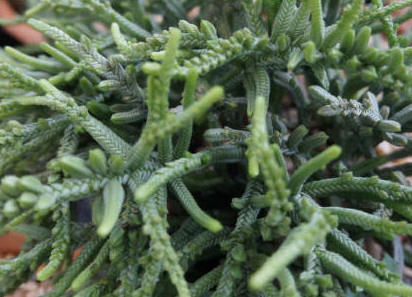 Crassula muscosa
Crassula lycopodioides
Crassula muscosa also named Crassula lycopodioides is a succulent
plant native to South Africa and Namibia, belonging to the family
of Crassulaceae and to the genus Crassula. It is a houseplant
grown worldwide and commonly known as Rattail Crassula, Watch
Chain, Lizard's Tail, Zipper Plant and Princess Pine.
Crassula muscosa has very small, light green leaves that are
densely packed around a thin stem, and the arrangement of the
leaves around the stems gives them a square shape. It grows as an
intricate bush with very small yellow-green flowers, with a
maximum height of 15-20 cm. It is an invasive species and easily
propagated from stem cuttings.
Crassula muscosa is native to South Africa (the Cape Provinces,
the Free State and the Northern Provinces) and Namibia
|
| |
|
| |
|
|
Crassula rupestris
“This differs from C. ‘Jade Necklace’ in its thinner, more pendent
stems. The leaves are brightly edged with rd. It thrives in the
ground in light shade or frostless areas but is at its best in a
basket or hanging pot.”
|
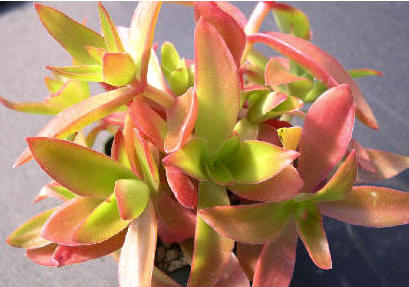 Crassula Capitella Campfire
Minimum Temp: 28 Exposure: Part Shade
Water: Deeply but infrequently
Type: Evergreen Persistence: Evergreen
Height: 1 foot Spread: 2-3 feet Growth Rate: Slow
Blooms: Summer Flowers: White Seasonal: --
Features:
Glowing yellow-orange leaves
Offsets quickly forming wide mats
Winter grower-semi-dormant in summer
Propagate by stem cuttings
Needs strong light but not hot afternoon sun to color properly
Outdoors in summer, indoors/greenhouse for protection in winter
when temps drop below freezing to prevent scarring
Reduce water in Autumn and even more in winter
|
| |
|
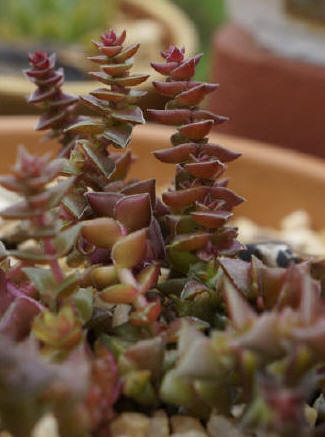 Crassula capitella
'Red Pagoda',
"Eye-catching, Crassula capitella 'Red Pagoda' is a branching
succulent with densely stacked, fleshy, triangular chartreuse
leaves adorned with bright crimson tips. Their color is brightest
in winter in response to long cool nights and bright sunlight.
drought tolerant plant, Mediterranean plant,Crassula corymbulosa
'Red Pagoda' d bright sunlight. |
| |
|
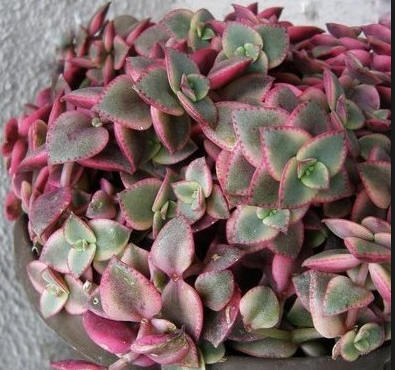
Crassula pellucida
ssp. marginalis f. rubra variegata
Calico Kitten
A
delightful little trailing plant, with masses of small
multicoloured fleshy leaves, which are green with yellow margins
when young, maturing to deep red with pink edges. This is best
displayed in a hanging basket, or a container on a windowsill.
Likes well-drained gritty compost, and full sun.
tender
|
|

Crassula rupestris
common name Jade Necklace or Chinese Pagoda, is a species of succulent in
the genus Crassula belonging to the family Crassulaceae.
a slow-growing small plant reaching a height of 15–20 cm. The thick
rounded leaves are green with red edges. They are tightly stacked
along the stem and store water, as they are covered with a cuticle
to limit the evaporation. An inflorescence with small star-shaped
pink-tinged flowers may appear on mature plants in winter if they
are given proper conditions of temperature. This plant prefers
direct light and as a houseplant is very easy to maintain.
This species is native to South Africa, Lesotho and Swaziland.
|
| |
|
| |
|
|
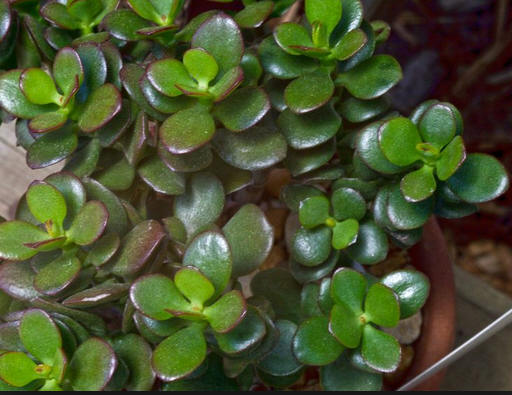 Crassula ovata
This is probably the best known as MoneyPlant jade plant Crassula as
it tolerates a certain amount of neglect. Specimens are seen on
window-ledges and in offices everywhere. With proper care the
plant can become a large 6-8 ft shrub, with fragrant flowers
during the Winter if kept just frost free. The thick stems branch
sparingly at the base, but more freely as the plant matures. The
brittle, jointed stems have obovate green
leaves, becoming reddened
in full sun. Native to the Western
Cape of South
Africa. |
| |
|
| |
|
|
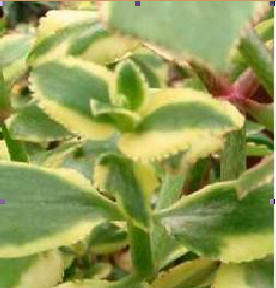
Crassula_sarmentosa
Light shade to full sun,
generally needs full sun part of the day to bloom
Origin: South
Africa (Cape
Province to KwaZulu-Natal)
Growth Habits: Succulent shrub,
4 feet tall (1.2 m)
or use for a trailing plant
Regular water in summer
fairly drought tolerant
tender
|
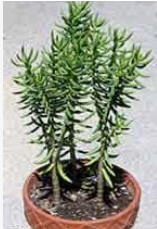 |
Crassula tetragona
is a succulent plant native to Southern Africa. It is popularly
named the "miniature pine tree" among ornamental plant
enthusiasts, for its popular use as a "pine tree" in Bonsai.
The plant is erect or spreads shrub less to 1 m (3 ft). Leaves are
green to dark green in color with white flowers that come up in
summer. used as a remedy for diarrhoea.
The plant requires a reasonable amount of water; more water is
needed if flower buds are present. Most species prefer full sun,
although some sub-species could be sensitive to too much sun. The
plant is resistant to frost, but temperatures above 40 °F (4 °C)
(6C) are best. The plant may be propagated from leaves and
cuttings. It does not suffer from pests, other than the occasional
mealy bug.
|
| |
|
|

Crassula arborescens,
the silver jade, silver
dollar plant, beestebul, Chinese jade, money plant, or money tree,
is a species of succulent plant in the Crassulaceae family. It is
an endemic plant of the Western Cape, South Africa. It is a 2 to
4 ft (0.6 to 1.2 m) succulent shrub. It has round gray "Silver
Dollar" leaves. It blooms in winter, with white to pink flowers.
It is cultivated as an ornamental plant for use in drought
tolerant and succulent gardens, and in container gardens. It is
also suitable for growing indoors as a houseplant.
|
|
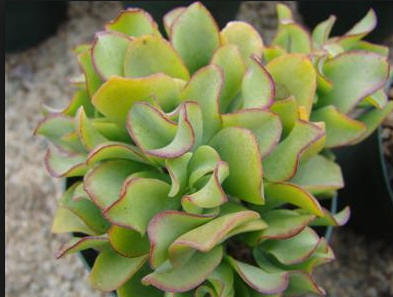
Crassula arborescens
subsp. undulatifolia “Hankey”
Known as Ripple jade plant
This cultivar has blueish undulating leaves
Small to medium sized shrubs with very attractive evergreen
foliage
Very hardy and easy to grow plants
Good bonsai subject |
| |
|
| |
|
|
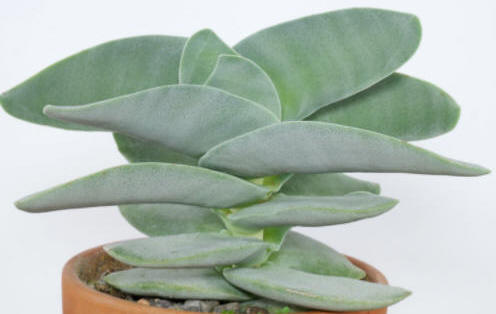 Crassula falcata
known by the common names airplane plant and propeller plant, is a
succulent plant endemic to South Africa, from the Cape of Good
Hope. The foliage is gray-green with striking texture, on plants
that grow to 2 feet (0.61 m) tall. The flowers are tiny and
scarlet red, that rise in dense clusters above the foliage for a
month in summer. Crassula falcata is cultivated
|
| |
|
| |
|
|
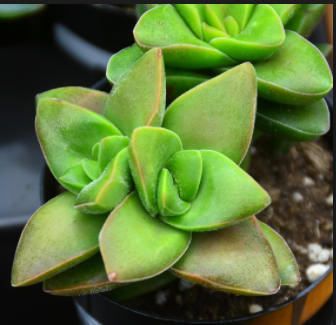 Crassula Springtime
This succulent has fleshy green leaves that are densely packed
around a thin stem, and the arrangement of the leaves around the
stems gives them a square shape. It grows as an intricate bush
with bright pink flowers, with a maximum height of 15-20 cm.
Lovely clusters of starry, light pink flowers appear in winter and
contrast nicely with the small, dense, mounded silver foliage, it
is very showy and one of the best Crassulas for pink flowers, a
beauty!!! Description: Slow growing pretty hybrid up to 15 cm
tall, good as ground cover or in hanging basket.
|
| |
|
| |
|
|
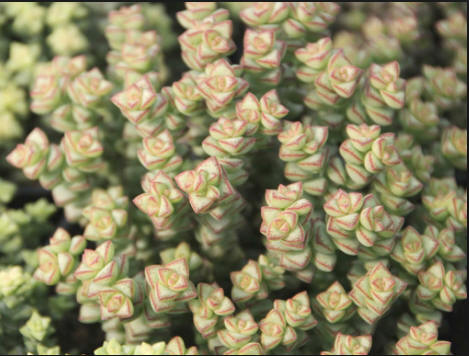 Crassula 'Pastel'
(Variegated Tom Thumb) is a Japanese variegated mutant of Crassula
'Tom Thumb'. It is a charming, miniature succulent plant up to 6
inches (15 cm) tall, with tiny, triangular leaves in opposing
ranks on stems. The variegated leaves are up to 0.2 inch (5 mm)
long and have colorful miniature, pagoda-like branching leaves ,
that looks like a mini, compact 'Necklace' or Crassula perforata
variety. Even though regarded as a common crassula, that does not
prevent it from being one of the most exquisite. It originates
from a chance cross between Crassula rupestris .. rupestris (ssp. rupestris)
and Crassula
rupestris ssp. marnieriana and
was found by W. J. Ruysch, The Netherlands. When in flower the
plant is is only 10-12 cm in height, but grows well and should
prove an interesting and worth while addition .
|
| |
|
|
 |
|
| |
|
|
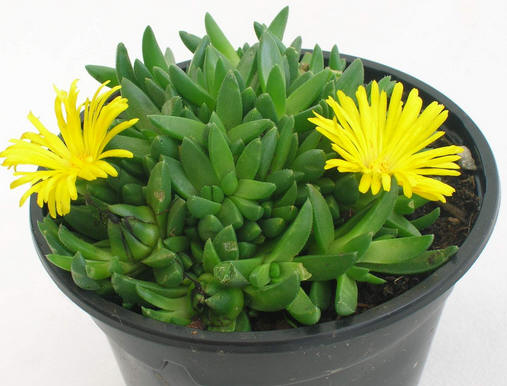 Delosperma
('delos'=evident, 'sperma'=seed)
is a genus of around 100 species of succulent plants, formerly
included in Mesembryanthemum in the family Aizoaceae.
The family is common in
southern and eastern Africa. easy grown we grow several colours
good to -1
|
| |
|
|
|
|
| |
|
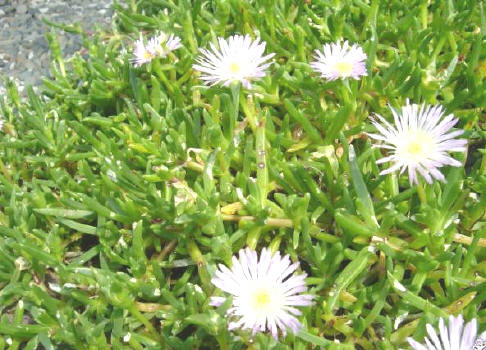 Native
Iceplant
(Ground Cover)
Coastal creeping succulent. White-mauve flowers (summer).
Frost tender
|
|
Drosanthemum |
|
| |
|
|
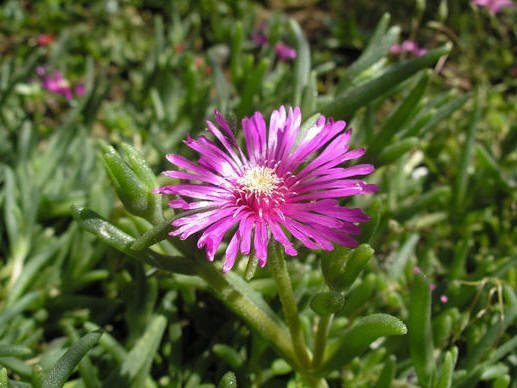 Drosanthemum
("dewflowers") is a genus of succulent
plants in the ice plant family native southern Africa.
The name Drosanthemum means "Dew-flower" in Greek, and refers to
the characteristic shiny translucent papillae, which cover the
succulent leaves and flower buds
Drosanthemum micans
Drosanthemum paxianum
Drosanthemum speciosum |
| |
|
|
 family, native to
semi-desert areas of Central America, Mexico and
Echeveria is a large genus
of flowering plants in the Crassulaceae
northwestern
South America.Plants may be evergreen or deciduous. Flowers on
short stalks (cymes) arise from compact rosettes of succulent
fleshy, often brightly coloured leaves. Species are polycarpic,
meaning that they may flower and set seed many times over the
course of their lifetimes. Often numerous offsets are produced,
Many Echeveria species are popular as ornamental garden plants.
They are drought-resistant, although they do better with regular
deep watering and fertilizing. Most will tolerate shade and some
frost, although hybrids tend to be less tolerant. Most lose their
lower leaves in winter; as a result, after a few years, the plants
lose their attractive, compact appearance and need to be re-rooted
or propagated. In addition, if not removed, the shed leaves may
decay, harboring fungus that can then infect the plant.
|
| |
|
|
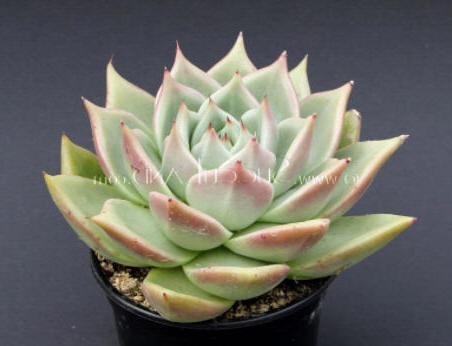 Echeveria agavoides
is a species of flowering plant in the Crassulaceae family, native
to rocky areas of Mexico,
E. agavoides is a small, stemless succulent plant, 8–12 cm (3–5
in) tall, with a rosette of leaves 7–15 cm (3–6 in) in diameter.
It is often solitary, but old plants in good condition grow
offsets. The leaves are green, triangular, thicker (6 mm) and more
acute than the other echeverias - hence the explanation of their
name agavoides, "looking like an agave". Some varieties with
bright light have reddish (or bronze) tips and some forms have
slightly red to very red margins. The inflorescences in summer
appear on slender, single-sided cymes up to 50 cm (20 in) long.
The flowers are pink, orange or red, the petals tipped with dark
yellow
As with most echeverias, E. agavoides fears moisture and prefers
mineral soils, growing best in light and even direct sunshine,
which aids flowering. In order to flower, plants need rest in the
winter, without water and in a cold place - but not less than 5 °C
(41 °F). In temperate regions they must be kept indoors during
winter, but may be placed outside during the summer months
Many hybrids have been created to obtain more brightly colored
flowers or leaves.
The easiest methods of propagation are leaf cuttings and division
of older plants.
|
| |
|
| |
|
|
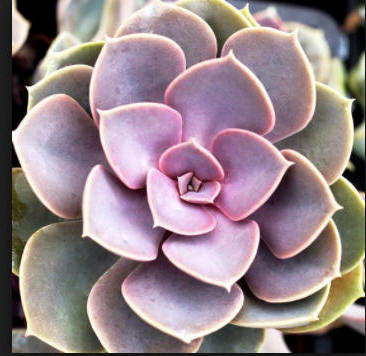 Echeveria ‘Perle Von Nürnberg’
is a beautiful succulent that has
interestingly colored acuminate leaves that are a pale grayish
brown with pink highlights and have a white powdery dusting. The
leaves overlap in solitary, up to 6 inches (15 cm) wide rosettes.
The flowers are corral pink in color on the exterior with a yellow
interior and appear in summer on 1 foot (30 cm) long
reddish-stemmed inflorescences.
How to Grow and Care
Most of the common Echeveria species are not complicated
succulents to grow, provided you follow a few basic rules. First,
be careful never to let water sit in the rosette as it can cause
rot or fungal diseases that will kill the plant. Additionally,
remove dead leaves from the bottom of the plant as it grows. These
dead leaves provide a haven for pests, and Echeveria are
susceptible to mealy bugs. As with all succulents, careful
watering habits and plenty of light will help ensure success. Most
Echeveria can be easily propagated from leaf cuttings.
Repot as needed, preferably during the warm season. To repot a
succulent, make sure the soil is dry before repotting, then gently
remove the pot. Knock away the old soil from the roots, making
sure to remove any rotted or dead roots in the process… |
| |
|
|
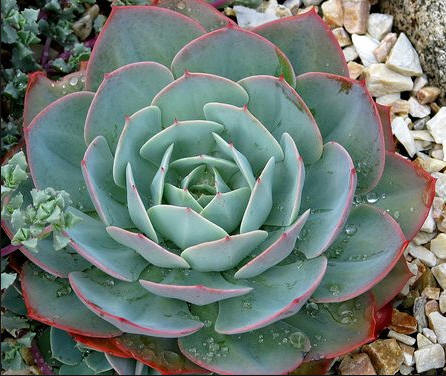
Echeveria imbricata
Tight rosettes of flat grey-green leaves
that when mature, form offsets freely to produce large solid
clumps. It has a branched arching inflorescence bearing clusters
of red and yellow flowers in the spring and early summer. Ideal
Conditions: Prefers full sun, or partial shade with free-draining
soil or compost. Possible Situation: Perfectly suited for planting
in gravel gardens, paved areas, rockeries and small containers.
Try mixing with other succulents and alpines. |
| |
|
| |
|
|
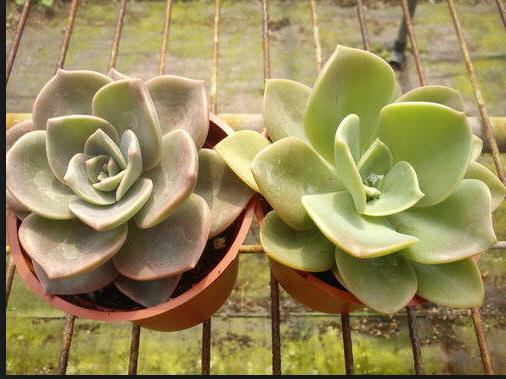 Echeveria
derex
popular succulents that
grow in attractive rosettes with beautiful leaves in a variety of
colors and sometimes stunning flowers. These plants have been
extensively hybridized, so in addition to the main species there
are many varieties that have been specially bred for interesting
leaf form and color. Light: Full sun. Perfect for a sunny window.
Water: Water during the summer and spring, making sure drainage is
immaculate. Reduce water in the winter to monthly.
Temperature: Prefers average summer temps (65ºF - 70ºF). In
winter, cool to 50ºF.
Soil: A well-drained succulent mix, with an ideal pH around 6.0
(slightly acidic).
Fertilizer: Feed with a controlled-release fertilizer in the
beginning of the season or weekly with a weak liquid solution. |
| |
|
| |
|
|

Echeveria prolifica
Echeveria prolifica is an
evergreen spreading succulent with small rosettes of fleshy,
plump, pale silvery-green leaves adorned with pink overtones.
In spring, it displays compact
clusters of bright yellow flowers |
| |
|
| |
|
|
 Echeveria
'Black Prince'
Echeveria 'Black Prince' -
(Black Hens and Chicks) - This succulent plant produces clumps of
short rosettes up to 3 inches wide with thin dark triangular,
blackish leaves. These leaves first emerge greenish but darken to
a deep lavender brown and with age the lower leaves widen out to
as much as 1 inch at the base with an acuminate tip that has fine
yellow edges. In late autumn to early winter appear the dark red
flowers on short stalks. Plant in full sun (best colour) or light
shade in a well-drained soil with occasional irrigation in spring
and summer months. Hardy to around 25°F. |
| |
|
| |
|
|
 Echeveria 'Doris
Taylor'
The woolly rose is an attractive succulent that forms rosettes of
pale-green, fleshy leaves covered with small white hairs. A
low-maintenance succulent, the woolly rose can easily thrive if
provided with the right conditions a stunning hairy leaved hybrid
Echeveria which grows to about 15cm and then branches and offsets
freely. This plant is quite hardy in Devon and ideal for temperate
gardens. The flowers are an attractive orange-yellow on short
stalks. It is a 1932 hybrid by W. Taylor (E. pulvinata x E. setosa).
|
| |
|
| |
|
|
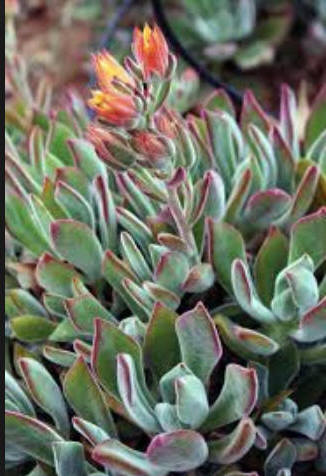 ECHEVERIA harmsii
Plush Plant
This soft little fuzzy succulent has beautiful leaf colour that
adds interest to small gardens and pots. It is a rosette-forming
species that hails from northern Mexico. This evergreen forms
small asymmetrical rosettes comprised of fleshy, football-shaped
leaves with a burnished-red cast along the leaf edges. The rosette
will occasionally send out pups, or lateral plantlets. As these
accumulate, the plant develops a mound-like habit.
This succulent has large, beautiful flowers, but it is not a heavy
bloomer. In spring it sends up stems topped with orange,
bell-shaped flowers with golden throats. Each stem may include
many flowers that open at different times for a longer season of
color. The blooms are highly attractive to hummingbirds.
Like most succulents, this plant prefers full sun and needs very
porous soil, whether grown in a pot or a frost free rock garden.
As plants age, they grow rangy but this can easily be remedied
with careful pruning. The cuttings root easily in moist sand.
Watering should be done sparingly as this is a very drought
tolerant plant. Feed it occasionally from spring to summer
occasionally with a liquid fertilizer solution at half strength.
|
| |
|
|
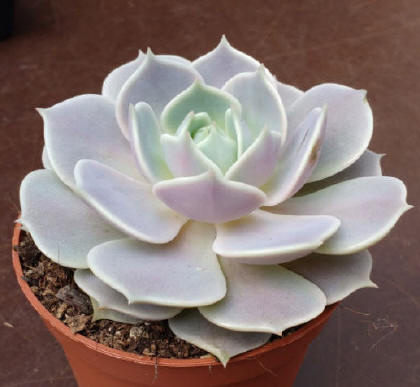 of of
Echeveria lola
Echevieria lola, or Mexican Hens and Chicks
Little known fact: Eceheveria lola is actually a hybrid two
different Echeveria species and was created by a man named Dick
Wright!
Plant it in a terracotta pot, but make sure it is not glazed.
Glazed pottery retains water. Likewise, ensure the pot is on a
saucer and that you remember to dump excess water from the saucer
after watering. You don’t want to let the plant sit in it.
Give your lola as much sunlight as you can! Bring it outside
during the sunny months if possible, or put it on a south-facing
windowsill. While the plant is hardy, it will not tolerate frost
so bring it inside if the temperature drops too low.
Water your lola every week or every other week during the growing
season (summer), depending on the heat and dryness of the air.
During the dormant season (winter), water it much less frequently.
Ensure that the soil becomes completely dry between each watering.
If you feel the need to fertilize (which should be rarely, maybe
once a year), dilute the fertilizer to half strength and include
it when you water.
Echeveria species are known colloquially as “hens and chicks”
because they clone themselves into incredibly cute plant babies
all the time! These “chicks” often hug tight to the mother, but
can be removed and repotted whenever you like.
|
| |
|
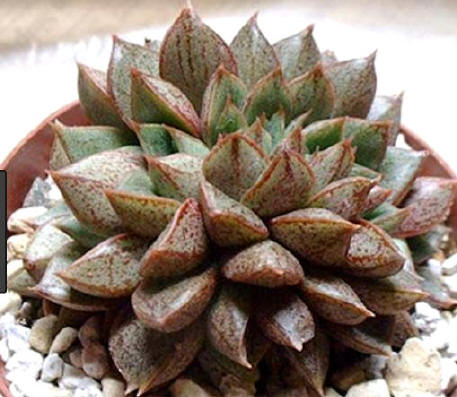 Echeveria
purpusorum
is a small slow growing and unusual species. This also is a plant
usually known as an Urbinia. It has glabrous, stem-less, succulent
rosettes, up to 6-8 cm in diameter and tall, it stay usually
solitary but it can offset to form a dense clump. Its
attractiveness lies in the beautifully speckleds one of the
slowest-growing Echeverias and it is necessary to cultivate it for
many years to get a nice specimen. is one tough succulent. This
means it's one of the easiest to care for. Just give it lots of
sunlight, water sparingly and you're good to go! Its colors can
change from green to brown to red all depending on the amount of
light it gets. Plant Care: Sun Full sun Water Average .
|
| |
|

Echeveria runyonii 'Topsy
Turvy'
This cultivar is a mutation originated in cultivation in
California. The standard Echeveria runyonii is found natively in
Mexico
Echeveria is named after the 18th century Spanish botanist
Atanasio Echeverria Codoy.
Common Names Mexican hens and chicks plant.
There is also a crested form which is Echeveria runyonii cv.
"Topsy-turvy" f. cristata which can be reproduced only
vegetatively. Only a fragment of the crested shoot is is used for
reproduction because leaves and normal shoots (non-crested) do not
produce the crested trait.
Topsy-turvy is one of the true monstrous forms of Echeveria
that 'breeds true' and won't revert back to it's natural form.
It is a profuse offesetter and can create large mounds of densely
crowded plants up to 20 x 35 cm (height by width). Parent plants
can get up to 25 cm across, but rarely do the offsets
he leaves are too narrow to form the perfect rosette usually
expected of Echeveria is a fast growing rosette-forming succulent,
up to 10 inches (25 cm) in diameter. The leaves are pale
blue-green to silvery-grey, up to 5 inches (12.5 cm) long and up 1
inch (2.5 cm) wide, often with pink tips runyonii, is a great
plant to use in terrariums, dish gardens and anywhere you
landscape.
|
Euphorbia
Contact with skin causes severe irritation,
redness and a burning sensation; contact with the eyes may cause
severe pain, and in some cases temporary blindness for several
days. Symptoms may worsen over 12 hours.
For eye exposures, flush eyes with fresh, cool water for at least
15 minutes and repeat after a few minutes. Seek medical attention
if there is no relief. Over-the-counter anti-histamines may
provide relief for some people.
If swallowed, it may cause burning to the mouth, lips, and tongue.
Deaths have been recorded from swallowing the latex, and anyone
swallowing some should seek medical attention. |
|

Euphorbia cereiformis
is a densely branched, perennial dwarf shrub, up to 8 inches (20
cm) tall, forming compact clumps. The stems are 7 to 10 ribbed and
deeply grooved between, up to 4 inches (10 cm) long and up to 1
inch (2.5 cm) in diameter. Leaves are tiny, succulent, lanceolate,
green in color, up to 0.16 inch (4 mm) long,
Flowers are wine-red, 0.2 inch (5 mm) in diameter, solitary
clustered at the end of the branches. native to Africa, forms
club-shaped stems to 4" in diameter with up to 15 ribs and dense,
gnarly persistent peduncles (residual dead flower stalks, etc.) to
1/2" in length. New growth is burgundy in color. Produces many
offsets, and grows to several feet in height. |
| |
|
|
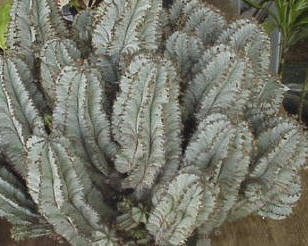 Euphorbia polygona,
native to South Africa, forms a ribbed chunky columnar plant of
glaucous grey-green and is heavily armed with spiny protuberances
("peduncles", otherwise known as persistent flower stalks). The
cultivar 'Snowflake' is chalky white and has fewer spiny
protuberances. It has been said that only a single 'Snowflake' was
ever found in Africa. Many new hybrids have been created using
'Snowflake' as it tends to pass on excellent genetics for
attractive plants. All Euphorbias contain a white sap that can be
irritating to eyes and mucous membranes. If contact is made with
this white sap, take care to not touch face or eyes before washing
hands with soap and water. Responds well to warmth, with its
active growth period in the late spring and summer months. Porous
soil with adequate drainage. Requires bright light for best
appearance, and should be given a winter resting period at which
time less water should be given. Protect from frost.
|
| |
|
|
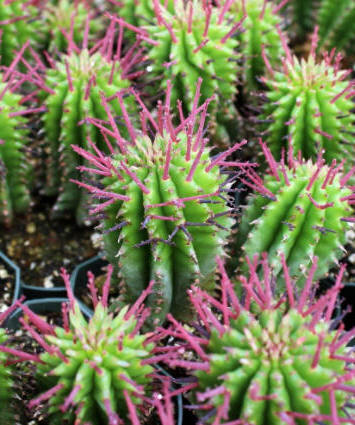 native to South Africa, forms a
ribbed chunky columnar plant of glaucous grey-green and is heavily
armed with spiny protuberances ("peduncles", otherwise known as
persistent flower stalks). The cultivar 'Snowflake' is chalky
white and has fewer spiny protuberances. It has been said that
only a single 'Snowflake' was ever found in Africa. Many new
hybrids have been created using 'Snowflake' as it tends to pass on
excellent genetics for attractive plants. All Euphorbias contain a
white sap that can be irritating to eyes and mucous membranes. If
contact is made with this white sap, take care to not touch face
or eyes before washing hands with soap and water. Responds well to
warmth, with its active growth period in the late spring and
summer months. Porous soil with adequate drainage. Requires bright
light for best appearance, and should be given a winter resting
period at which time less water should be given. Protect from
frost. |
| |
|
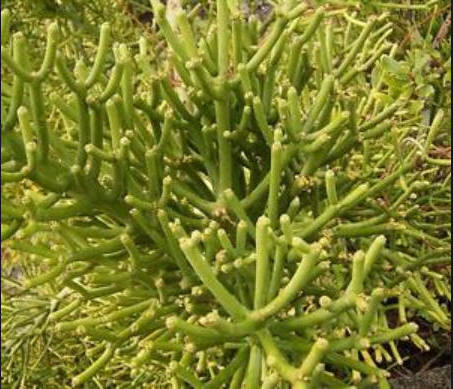 Euphorbia
tirucalli
firestick plants, Indian tree spurge, naked lady, pencil tree
A easy plant
It has a wide distribution in Africa, being prominently present in
northeastern, central and southern Africa. It may also be native
in other parts of the continent as well as some surrounding
islands and the Arabian peninsula and has been introduced to many
other tropical regions. Its status in India is uncertain. It grows
in dry areas, and is often used to feed cattle or as hedging.
The milky latex from E. tirucalli is extremely irritating to the
skin and mucosa and is toxic. contact with skin causes severe
irritation, redness and a burning sensation; contact with the eyes
may cause severe pain, and in some cases temporary blindness for
several days. Symptoms may worsen over 12 hours.
For eye exposures, flush eyes with fresh, cool water for at least
15 minutes and repeat after a few minutes. Seek medical attention
if there is no relief. Over-the-counter anti-histamines may
provide relief for some people.
If swallowed, it may cause burning to the mouth, lips, and tongue.
Deaths have been recorded from swallowing the latex, and anyone
swallowing some should seek medical attention.
|
| |
|
|
|
|
|
 Faucaria 'Tuberculosa
This
low maintenance succulent from South
Africa has thick triangular
leaves. The edges have white hair-like structures that look a
little like teeth.
Prefers full sun, or partial shade with
free-draining soil or compost.
Perfectly suited for planting in gravel
gardens, paved areas, rockeries and small containers. Try mixing
with other succulents and alpines
Small plants of 8 cm diameter, with thick
triangular leaves. On the edges of the leaves there are upright
teeth in opposite pairs that looks like an animal mouth. It may
become bushy.
The plants are light green, turning purple if exposed to strong
sunshine.
Golden yellow flowers appear from August in the centre of the
rosette.
|
|

|
|
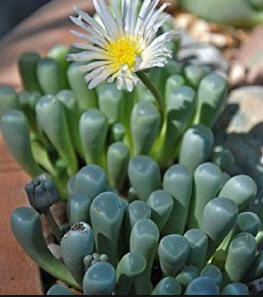 Fenestraria
rhopalophylla.
is the currently recognised species in this genus is Each leaf has
a epidermal window, a transparent window-like area, at its rounded
tip, it is for these window-like structures that the genus is
named (Latin: fenestra).
F. rhopalophylla appears very similar to Frithia pulchra, though
the leaves are a slightly different shape and F. rhopalophylla has
yellow flowers, compared to the pink flowers of F. pulchra.
In the wild, the plant commonly grows under sand, except for the
transparent tips, which allow light into the leaves for
photosynthesis.
The plant produces optical fibers made from crystalline Oxalic
acid which transmit light to subterranean photosynthetic sites.
native to Namaqualand in southern Africa and to Namibia. The
plants generally grow in sandy or calciferous soils under low <
100 mm rainfall, that occurs in the winter. |

Ledebouria socialis
Ledebouria socialis, the silver
squill or wood hyacinth, is a geophytic species of bulbous
perennial plant native to the Eastern Cape Province of South
Africa.
It was first described by John
Gilbert Baker as Scilla socialis in 1870.
It is often cultivated and
grows well with minimal care.
great in pots and collections
Socialis
means 'grows in pure stands', 'dominant', or 'growing in colonies' |
|

|
|
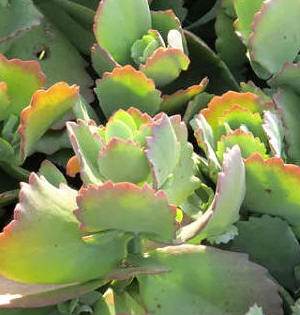 Rebutia heliosa
is a small, slow growing cactus, with
heads densely covered in brown areoles with short, about (1 mm)
long spines. The stems are spherical to shortly cylindrical, up to
1.2 inches (3 cm) tall and up to (3.5 cm) in diameter. The flowers
are long lasting (about 10 days), funnel-shaped, (5 cm) long, (4
cm) in diameter and orange to orange-red in color. The fruits are
purple red in color.
Watering should be done carefully, allowing the plant to almost
dry out between waterings. It’s imperative that the cactus is not
exposed to prolonged dampness and sitting water. make sure to use
fertilizer during the growing season for the best results. Repot
as needed, preferably during the warm season.
Native to Bolivia. |
Gasteraloe
|
|
 v v Gasteraloe
Gasteraloe (also known as × Gastrolea) is a genus of hybrid
plants, from mixtures of species from the Aloe or Aristaloe and
Gasteria genera.
× Gasteraloe hybrids are typically stemless or almost stemless.
Their succulent leaves, which are usually spotted or marked and
have toothed margins, form rosettes.
Gonialoe variegata and Aristaloe aristata are especially commonly
used for these hybrids, as they are far more amenable to
hybridization with gasterias than most other "aloes".
culltivate the saame as aloes
|
| |
|
|
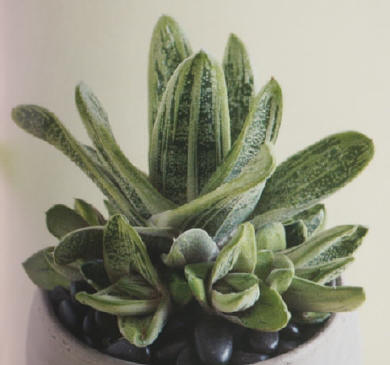 Gasteraloe
little warty |
| |
|
|
 Gasteraloe
Green ice
|
|

 |
|
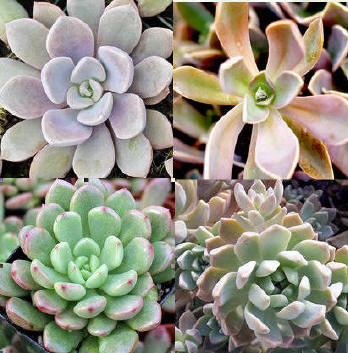
|
Graptoveria
is a
hybrid of Echeveria and Graptopetalum. Pachyveria is a hybrid of
Echeveria and Pachyphytum. Sedeveria is a hybrid of Echeveria and
Sedum.
Pachyphytum is a genus native to Mexico and a close relative of
Echeveria and Sedum. |
| |
|
|
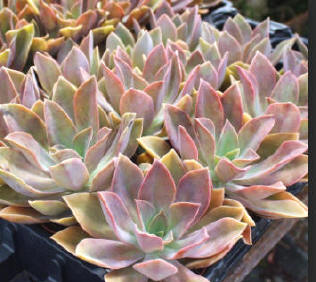 Graptoveria
'Fred Ives' is a pretty cross between Graptopetalum paraguayense
and Echeveria gibbiflora. frost free Light Aspect. Part Shade,
Full Sun, Full Sun Windowsill. good in Pot, Wall, Rockery, Garden,
Windowsill, Conservatory.
Spread & Height. Medium. |
| |
|
|
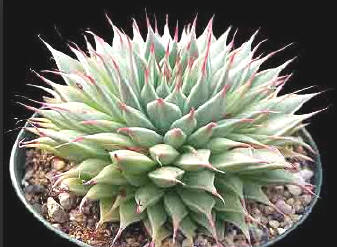 Graptoveria
Silver Star
Graptopetalum filiferum x Echeveria agavoides ‘Multifida’.
Eventually forming a 4in rosette, the closely spiralled leaves are
silvery green and each is tipped with a pinkish bristle. |
| |
|
|
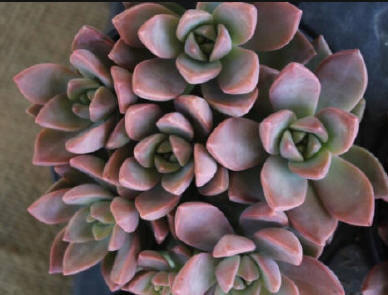 Graptosedum
‘California Sunset’
This succulent has compact, Echeveria-like rosettes with a unique,
orangish-pink color.
Long-cultivated and more widely-distributed than most of the
hybrids made by Robert Grim, The rosettes are at the tips of
eventually decumbent stems, which can simply be cut back and
restarted to maintain a more compact plant. New growth is a
grayish-green but soon takes on its distinctive coloration that is
enhanced by drought as well as cool winter temperatures. The
durability and grayish new leaves of this hybrid are imparted by
Graptopetalum paraguayense. The pastel coloration and white
flowers come from the other parent, S. adophi, another durable
Mexican succulent in the Crassulaceae. |
| |
|
| |
|
| |
|
| |
|
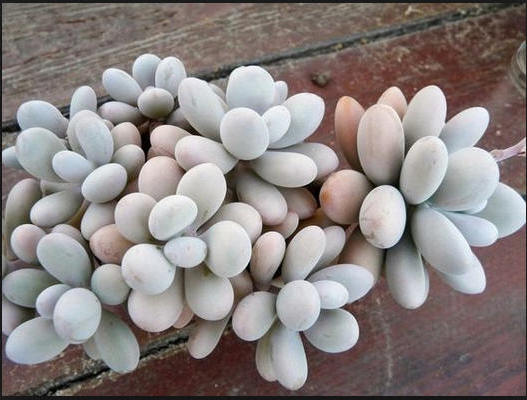
Graptopetalum amethystinum)
If you like
succulents, this one is as succulent as they get! Lavender
Pebbles (Graptopetalum amethystinum) is a
rare species from Mexico that looks more like moon rocks than a
plant! This cool succulent has plump, rounded leaves in lovely
shades of lavender, pink, and green. The leaves have a powdery
coating that adds to the eerie, moon rock look. If grown in a
hanging planter, the plant will spill over the edges 12 to 18
inches. Or let it trail along the ground like a bed of living
pebbles!
Lavender
Pebbles is related to Jade Plant and Echeveria (Crassulaceae
family). The "chubby" leaves are rounded at the tip, instead of
pointy like many related succulents. The lavender or rose
shades appear strongest in the newer leaves, while the older
growth becomes more greenish. If you rub off the powdery
coating, the colors are more vivid! The pretty, star-shaped
flowers appear in large numbers around Spring. The plant
normally hangs from steep cliffs in the wild, where it forms
multiple branches. You may root the branches if you wish, or
even the individual leaves. This is a true species, not a
hybrid. It will hybridize with some related succulents like
Echeverias and Sedums.
|
| |
|
|
 Gymnocalycium
commonly called chin cactus, is a genus of about 70 South American
species of cactus. The genus name Gymnocalycium (from Greek,
"naked calyx") refers to the flower buds bearing no hair or
spines.
Their main area of distribution is Argentina, part of Uruguay,
Paraguay, southern Bolivia and part of Brazil.
Most species are rather small varying from 4 to 15 centimetres in
size. In cultivation they are popular for their easy flowering
habits, and the flowers are generally brightly coloured. Where
temperatures fall below 10 °C (50 °F) they must be cultivated
under glass with heat.
|
|

 |
|
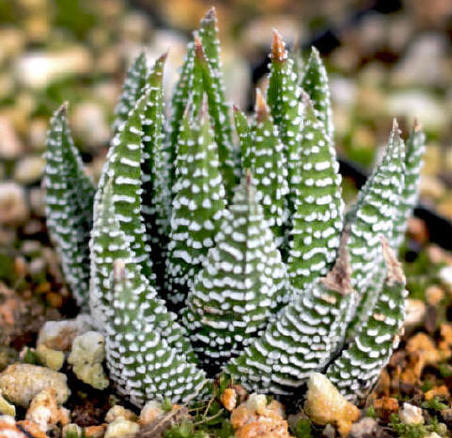
Haworthia fasciata
Haworthia is a large genus of small
succulent plants endemic to Southern Africa and they generally
resemble miniature aloes, except in their flowers, which are
distinctive in appearance. Horticulturally they are popular garden
and container plants.
Haworthias are small succulent plants, forming rosettes of leaves
from 3 cm (1.2 in) to exceptionally 30 cm (12 in) in diameter,
depending on the species. These rosettes are usually stemless but
in some species stems reach up to 50 cm (20 in). The
inflorescences of some species may exceed 40 cm (16 in) in height.
The plants can grow solitary or can be clump-forming. Many species
have firm, tough, fleshy leaves, usually dark green in colour,
whereas others are softer and contain leaf windows with
translucent panels through which sunlight can reach internal
photosynthetic tissues. Their flowers are small, and generally
white. Though they are very similar between species, flowers from
the species in hexangulares generally have green striations and
those from other species often have brown lines in the flowers.
However, their leaves show wide variations even within one
species. Additionally, when the plants are stressed (e.g deprived
of water), their colours can change to reds and purples. Depriving
them of nitrogen generally results in paler leaves. tender
|
| |
|
|
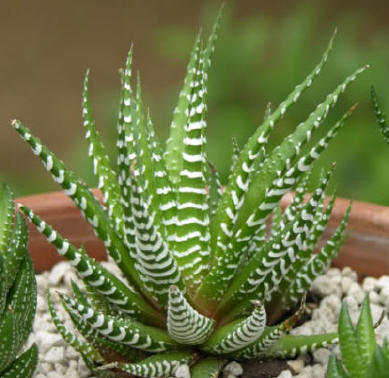 Haworthiopsis reinwardtii
formerly Haworthia reinwardtii,
is a species of succulent flowering plant in the family
Asphodelaceae, native to the Eastern Cape Province of South
Africa. It is one of the species of Haworthiopsis that is commonly
cultivated as an ornamental.
H. reinwardtii has typical thin, strongly tubercled leaves
It is a perennial succulent, with stems growing to 20 cm (8 in)in
height, with a basal rosette of white-spotted fleshy leaves
arranged in a spiral pattern, and racemes of tubular pinkish-white
flowers in spring. The plant spreads to form a mat, by means of
freely-produced offsets, also a convenient means of propagation.
|
| |
|
|
 Haworthia retusa
is a species of flowering plants of the genus Haworthia
endemic to a very small area around Riversdale, in the Western
Cape Province in South Africa.
Growing to 10 cm (3.9 in) tall and broad, it is a perennial
succulent with thick triangular leaves and small white tubular
flowers held in 50 cm (20 in) tall racemes.
The genus name Haworthia honors the British botanist Adrian Hardy
Haworth (1767–1833), while the species epitheton retusa derives
from Latin and refers to the "retused" leaf-shape. recurved shape
of the leaves. The upturned, recurved face of each leaf forms a
triangle, which is transparent (and often lined). The species can
be easily recognised by its leaf-top windows, which are
distinctively shiny.
Plants grow as tight rosettes of thick, firm, fleshy, highly
recurved/truncated leaves. It is usually a solitary rosette in the
wild. In cultivation it can offset, and even form clumps.
This species is one of the "retuse" species of Haworthia, meaning
that it usually grows sunken beneath the ground with its flattened
leaves only showing on the surface. Its rosette of succulent
leaves are turned back ("retuse") so as to provide a flat and
level face, on the surface of the ground. In temperate regions it
is normally grown under glass as it does not survive temperatures
below freezing. In the UK it has gained the Royal Horticultural
Society’s Award of Garden Merit.
|
| |
|
| |
|
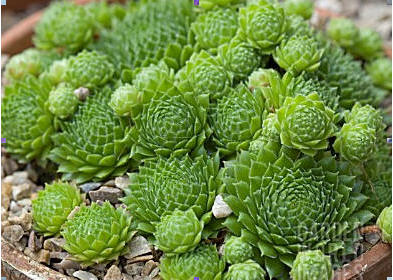
Jovibarba
Jovibarba
("beard of Jupiter") is a small genus of three species of
succulent flowering plants in the family Crassulaceae, endemic to
mountainous regions in the south-eastern quadrant of Europe.
closely related to Sempervivum,.
Jovibarba
have pale-greenish-yellow or yellow flowers with about six
petals, while Sempervivum have generally pinkish flowers with
around twice as many petals, which open more widely than jovibarba
flowers.
jovibarba
species are commonly called rollers. They produce offsets that are
lightly attached and easily pop off and roll away from the mother
plant. Offsets survive the main rosette, which is monocarp.
grow the
same as Sempervivum. |
|


Kalanchoe is a genus of
about 125 species of tropical, succulent flowering plants in the
family Crassulaceae, mainly native to Madagascar and tropical
Africa.
Most are shrubs or perennial herbaceous plants, but a few are
annual or biennial. The largest, Kalanchoe beharensis from
Madagascar, can reach 6 m (20 ft) tall, but most species are
less
than 1 m (3 ft) tall.
Kalanchoes are characterized by opening their flowers by growing
new cells on the inner
surface of the petals to force them outwards,
and on the outside of the
petals to close them.
Kalanchoe flowers are
divided into 4 sections with 8 stamens.
The petals are fused into a
tube,
in a similar way to some
related genera such as Cotyledon. |
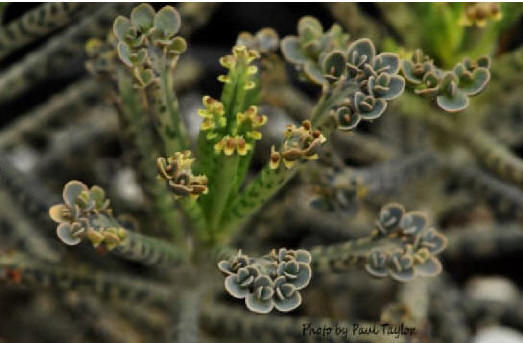 + +
Kalanchoe
tubiflora delagoensis
Kalanchoe delagoensis
"Mother
of Thousands"
This plant gets a lot of attention from visitors for its
architectural accents, its willingness to grow nearly anywhere,
and the ease with which the babies can be pulled or scooped away
where not wanted. They have to be fairly large to bloom, and a
large potful of them in bloom can be spectacular.
Description: "Mother of Thousands" reproduces via "plantlets" on
that grow on the ends of each leaf & drop off.... they fall into
the dirt and grow from there. They grow everywhere, don't need
dirt, In optimal conditions it grows as an annual/biannual and
typically grows to about 1 m before blooming in the winter. Plants
die back after blooming and new shoots can arise from the roots.
Produces umbels of trumpet-shaped 2-3 cm long salmon to scarlet
flowers that dangle in clusters from the top of the plant. They
are very beautiful but hard to see.
Blooming season: Due to intense vegetative reproduction, this
plant rarely blooms. But well grown larger specimens can flower
profusely in winter, even with little or no water. The flowers
last about 5 weeks so it is well worthwhile trying to get some |
|
 Kalanchoe luciae:
Also know as 'Flapjacks' and 'Paddle Plant'. Forms a basal rosette
of large, rounded, fleshy stalkless leaves. Gray-green with red
margins. Full to part sun. Drought and heat tolerant. Not frost
hardy.
|
|
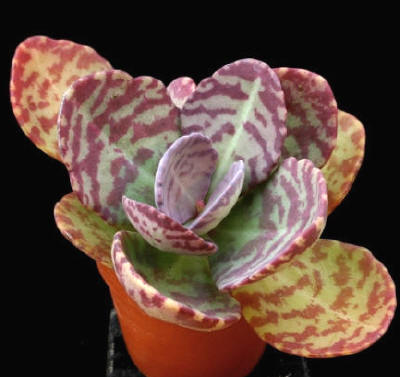 Kalanchoë humilis
'Desert Surprise' (A selected clone)
Paddle shaped blue-green leaves with spectacular purple markings.
The brown/purple blotches need light to develop fully.
It is very easy to grow and drought-resistant, it makes an
interesting plant in any collection .
is also easy to take care as indoor plant.
It thrives in nutrient poor soils consisting of equal parts of
loam and sand, with pumice or lava grit added to ensure good
drainage.
It takes a good deal of sun, though still prefers some shade.
It needs little watering in autumn and spring while in summer it
should be watered thoroughly and allowed to dry before watering
again.
In winter give only occasional watering (only when the plant
starts shrivelling), but it will generally grow even in winter if
given water. These plants will survive on neglect. Over-watering
is the most common cause of plant failure.
hardy to -2 ° C for short periods.
The flowers are not much of an attraction and can be removed.
It is propagated by removal of small offsets at the base of the
main plant or by leaf and stem cuttings.
It is an ideal plant for containers or rock gardens.
|
|
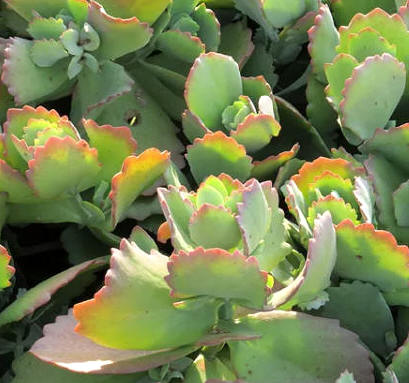 Kalanchoe longiflora coccinea
Kalanchoe longiflora coccinea is an interesting succulent house
plant here in the UK. Native to Brazil, the leaves of this
Kalanchoe can change from a deep green to crimson depending on its
environment.
The foliage turns crimson in response to drought, cold or full
sun.
This plant then produces yellow flowers on tall spikes during
summer months and even into autumn/winter.
The flowers can last many weeks.
Remove dead blooms to encourage repeat flowering.
Likes full sun if possible.
Allow the plant to partially dry out between waterings.
Do not allow this plant to stand in water.
Tough and relatively easy to look after.keep frost free.
|
|
 Kalanchoe marnieriana -
Marnier's Kalanchoe: Blue-green foliage with flushes of pink. Rose
pink blooms. Nice in containers. Excellent indoor plant. Tender
succulent, protect from freezing.
Green
18" tall 24" wide
Filtered sun, bright light
9"-12" Vertical Grower / Tall Stem
Container Garden, House or Office Plant
|
|
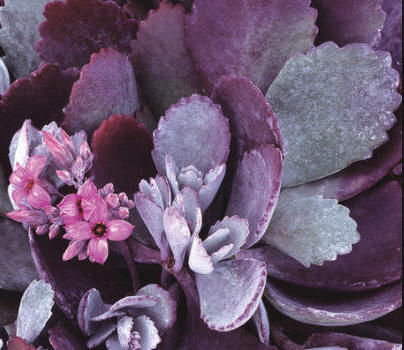 Kalanchoe pumila
flower dust plant
is a species of flowering plant in the family Crassulaceae, native
to Madagascar. It is a spreading, dwarf succulent subshrub growing
to 20 cm (8 in) tall and 45 cm (18 in) wide, with arching stems of
frosted leaves, and clusters of purple-veined pink flowers in
spring. As the minimum temperature for cultivation is 12 °C (54
°F), in temperate regions it is grown under glass as a houseplant.
The Latin specific epithet pumila means dwarf or low-growing.
This plant has gained the Royal Horticultural Society's Award of
Garden Merit.
|
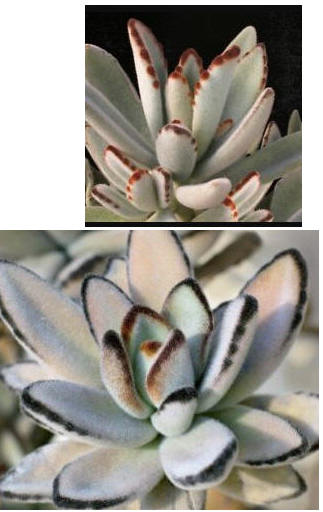 kalanchoe tormentosa
nigra
Panda Plant
Pussy Ears
Teddy Bear Cactus
Leaves are poisonous Roots are poisonous
The flowers are the most toxic part.
Containers: Needs excellent drainage in pots
tender native to Madagascar species being a succulent type species
grows thick leaves for water storage purposes, which means
watering less often for the grower. These leaves are covered in
tiny hairs that give the plant a velvety look and feel.
grows up to approximately 1.5 ft with a thick stem that produces
branches and many groups of leaves, once it matures. suitable
for growing in a hanging basket
leaves are greyish green in color that have brown spotted tips.
it's rare to see flowers bloom indoors, so it's grown for
primarily it's foliage within homes or offices. I have never seen
one of these flower
hanging baskets containers or sitting with a conservatory. A
conservatory is ideal because they do like their bright light and
some sun. Whilst they're still small and growing, then near
windows and on shelves which receive enough sunlight are good
spots for displaying them.
|
|


Lampranthus Plants
easy to look after. They like to grow in dry soil so only water in
very prolonged dry spells. Once the season is over, cut the plants
back by pruning the dead stems in the autumn. If you want more
plants then take cuttings in the springtime. |
 Lampranthus aureus
Golden Ice Plant, Orange Ice Plant
Family: Aizoaceae (Ice
plant family)
Golden Ice Plant is a neatly rounded,
erect, succulent plant that grows up to about half a meter tall.
The leaves are paired, free or slightly fused at the base, dark
green, up to 5 cm long. The plant is liked for its unbelievably
bright orange flowers. The shiny orange flowers are borne singly
or in clusters on short stalks, are 6 cm in diameter. There are
some yellow forms of this plant too. Flowers are followed by a
woody fruit capsule that has five compartments. Golden Ice Plant
is native to South Africa, and grown as an ornamental in India.
|
|
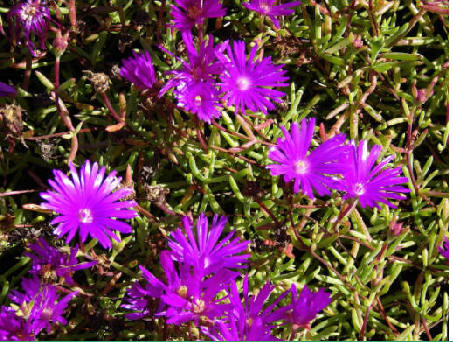 Lampranthus roseus
This is a frequently cultivated and a
rewarding plant. It is easily propagated from seed or cuttings and
needs a sunny position. Seed can be sown at any time of the year
in shallow trays in a sandy mixture and germination is within 3
weeks. Cuttings are best planted during the summer months. The
plants are short-lived and are best replaced every 3 years.
Lampranthus roseus prefers a sunny, well-drained slope. The plants
thrive in rockeries or containers in a sunny position. Plants are
subject to downy mildew and should be sprayed with Ridomil from
midwinter to just before flowering. |
| |
|
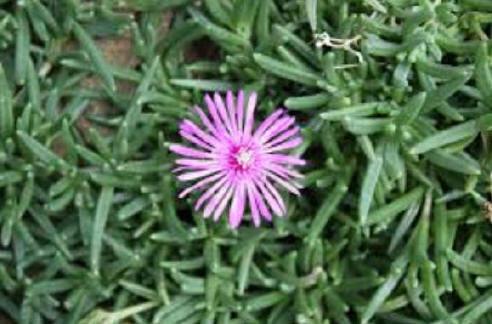
Lampranthus spectabilis
also placed in Mesembryanthemaceae)
Lampranthus spectabilis (
Common name
trailing ice plant shining-flowers" in Latin
Plants creeping. Flowers red, pink or white ca. 5-8cm across,
flowering in all seasons (mainly in Spring to Summer). Perennial
plants.
|
| |
|
Lithops
is a genus of succulent plants in the ice plant family, Aizoaceae.
Members of the genus are native to southern Africa. The name is
derived from the Ancient Greek words λίθος (lithos), meaning
"stone," and ὄψ (ops), meaning "face," referring to the stone-like
appearance of the plants. They avoid being eaten by blending in
with surrounding rocks and are often known as pebble plants or
living stones. The formation of the name from the Greek "-ops"
means that even a single plant is called a Lithops.
|
|
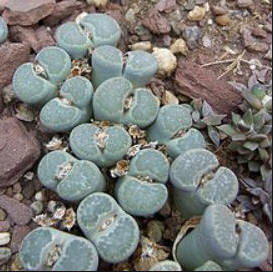
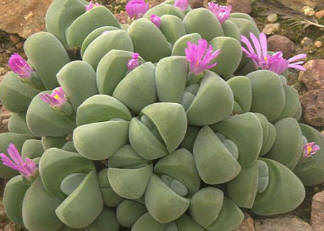
Lithops
is a genus of succulent plants in the ice plant family, Aizoaceae.
Members of the genus are native to southern Africa. The name is
derived from the Ancient Greek words λίθος (lithos), meaning
"stone," and ὄψ (ops), meaning "face," referring to the stone-like
appearance of the plants. They avoid being eaten by blending in
with surrounding rocks and are often known as pebble plants or
living stones. The formation of the name from the Greek "-ops"
means that even a single plant is called a Lithops.
Individual Lithops plants consist of one or more pairs of bulbous,
almost fused leaves opposite to each other and hardly any stem.
Lithops hookeri.
Two new leaf pairs are emerging between the old one, leading to a
double-headed plant
The slit between the leaves contains the meristem and produces
flowers and new leaves.
The leaves of Lithops are mostly buried below the surface of the
soil, with a partially or completely translucent top surface known
as a leaf window which allows light to enter the interior of the
leaves for photosynthesis.
Yellow or white flowers emerge from the fissure between the leaves
after the new leaf pair has fully matured, one per leaf pair. This
is usually in autumn, but can be before the summer solstice in L.
pseudotruncatella and after the winter solstice in L. optica. The
flowers are often sweetly scented.
The most startling adaptation of Lithops is the colouring of the
leaves. The leaves are fenestrated, and the epidermal windows are
patterned in various shades of cream, grey, and brown, with darker
windowed areas, dots, and red lines, according to species and
local conditions. The markings function as remarkable camouflage
for the plant in its typical stone-like environment.
Lithops require pollination from a separate plant. Like most
mesembs, Lithops fruit is a dry capsule that opens when it becomes
wet; some seeds may be ejected by falling raindrops, and the
capsule re-closes when it dries out.
Lithops occur naturally across wide areas of Namibia and South
Africa. |
Mammillaria
The genus Mammillaria is
one of the largest in the cactus family (Cactaceae), with
currently 200 known species and varieties recognized. Most of the
mammillarias are native to Mexico, but some come from the
southwest United States, the Caribbean, Colombia, Venezuela,
Guatemala and Honduras. The common name "pincushion cactus" refers
to this and the closely related genus Escobaria. |
|
|
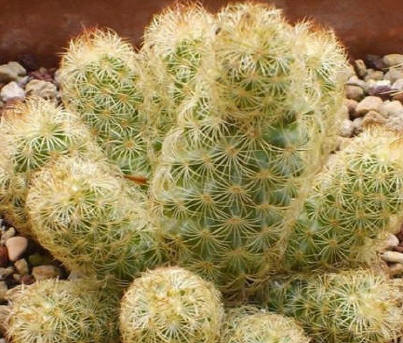
Mammillaria elongata
(gold lace cactus, ladyfinger cactus) is a species of flowering
plant in the Cactaceae family, native to central Mexico. Growing
to 15 cm (6 in) tall by 30 cm (12 in) wide, it consists of densely
packed clusters of elongated oval stems, covered in harmless
yellow or brown spines, and in spring producing white or yellow
flowers.
It is among the commonest and most variable of its genus in
nature, and is a popular subject for cultivation.[1][2] It has
gained the Royal Horticultural Society's Award of Garden Merit.
Cultivars
Golden Stars"Copper King""Cristata" (Brain Cactus)
|
|
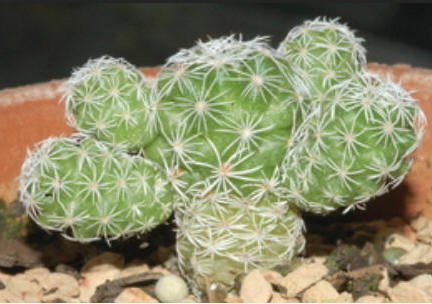 Mammillaria gracilis
‘Arizona Snowcap’
‘Arizona Snowcap’ is a small cactus, up to 4 inches (10 cm) tall
and up to 5 inches (12.5 cm) wide. The stems are cylindrical, dark
green, almost concealed by the spines, up to 3.2 inches (8 cm)
long and up to 1.2 inches (3 cm) in diameter, and branching
profusely by sides. Spines are short, white and thick. The flowers
are small, cream-yellow with pinkish or brownish midstripe, up to
0.7 inch (17 mm) long and up to 0.5 inch (12 mm) wide.
To encourage better flowering, allow the plants to enjoy a cooling
period in the winter and suspend watering. Unlike many other
cacti, which use their ribs as storage devices, the Mammillaria
feature raised tubercles, from which spines emerge. When you
water, the tubercles will expand to allow for increased water
storage.
The flowers emerge from the axils of these tubercles on the
previous year’s growth, which accounts for their interesting halo
effect.
keep very dry winter and use a fertilizer during the growing
season for the best results.
|
Pachyveria
plants do best in desert and arid climates, and grow well in
porous, well-drained soil. They grow well in full sun, though
prefer a bit of shade in more sizzling heat of 92 and higher
degrees Fahrenheit (33 degrees Celsius). They are drought and heat
wave tolerant, but love lots of summer time water, and hardy to
around 30-35 degrees Fahrenheit (-1 to 1 degrees Celsius). |
| |
|
 Pachyveria glauca
Little Jewel' succulent plants are hybrids in the nothogenus × Pachyveria (Pachyphytum
and Echeveria). This plant has cylindrical tapered leaves,
shading from powdery blue with a of purple at the bottom of the
plant to a light green at the points of the top leaves. That color
slowly darkens down the length of the plant
This plant propagates itself
by dropping leaves, which then sprout new plants. |
|
|
|
|
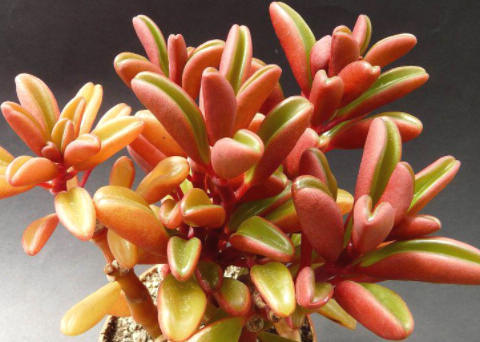 Peperomia
graveolens
ENGLISH: ruby peperomia, Ruby Glow
Description: Peperomia graveolens is a beautiful evergreen herb
with an aboveground growth habit. It has glowing wine red stems
with glossy red succulent leaves with clear green "windows" on
their surfaces, |
| |
|
|
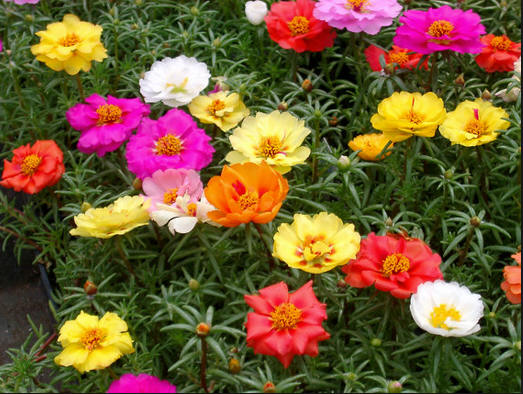
Portulaca grandiflora
Moss Rose is easy to grow. Grow Moss Rose plants in full sun.
Plants prefer average to poor soils. They prefer loose, sandy or
loam soil. A well draining composition is important.
Moss Rose plants are drought and heat tolerant. In the flower
garden, watering is seldom needed. If growing in containers or
hanging pots, allow the soil to dry between watering. Add a
general purpose, high nitrogen fertilizer when first planting, to
help them to get a good start. Add a high Phosphorous fertilizer
just before blooming. No other fertilizer applications should be
needed for the season. Moss Rose produce tough,
long lasting, rose-like blooms, in early summer. Pinch or deadhead
spent flowers to promote more blooms. Prune
plants to create a fuller, neater appearance. Provide plenty of
air circulation through the plant to help avoid fungal disease.
Plants are annuals that are very susceptible to frost. Cover them
up whenever cold temperatures are expected
|
| |
|
| |
|
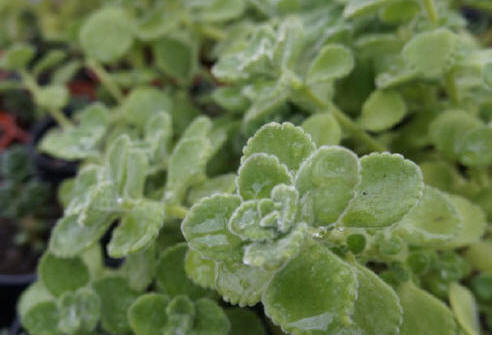 Plectranthus tomentosa;
vick's vapo-rub plant This perennial
succulent smells just like the popular cough and congestion rub a
strong, with its distinctive menthol and camphor scent. The odour
is stronger when the leaves are crushed.
green leaves that are covered with fine hairs. It can reach a
height of 30 inches (75cm) tall. Small, purple flowers will bloom
in the early spring and again in the autum.
Vick’s VapoRub Plant is perfect for beginners! These succulents
would be ideal for both container gardening (i.e hanging baskets,
window boxes, etc..) and garden beds. It is low maintenance and
like all other succulents, it is drought tolerant and doesn’t
require much water. Plus, the scent of the plant is known to repel
mosquitoes! Simply plant in well-draining soil in full sun to
partial shade. Be careful not to over water them, which can turn
the leaves yellow and mushy or lead to stem rot. Allow the soil to
dry between watering.
And yes, you can use the plant to help relieve congestion when you
are sick! Add the crushed leaves into some hot water and inhale
the steam. You should be able to breathe easier afterwards!
|
|

(known as elephant bush,
dwarf jade plant, porkbush and spekboom in Afrikaans) is a
small-leaved succulent plant found in South Africa.
It is a soft-wooded, semi-evergreen upright shrub or small tree,
usually 2.5–4.5 metres (8–15 ft) tall.
It is very widespread in the east of South Africa |
|

Portulacaria afra
Portulacaria afra (Elephant Food) - An
upright growing plant with reddish brown stems and 1/2 inch long
emerald green succulent leaves. Plant in sun or shade with little
or no supplemental irrigation. Hardy to at least 25° F can be kept
almost any size with pruning. T common English name is Porkbush
and the Afrikaans name is Spekboom, which translates from two
words, 'spek' meaning "bacon" and 'boom' meaning "tree" as Bacon
Tree. The names come from the fact that the leaves are edible,
though with a sour flavor.
In the wilds of South Africa, large plants do survive the winter
frosts by growing dense enough to provide their own natural cover.
Drought-tolerant and fire-resistant,
Minimum Avg. Temperature: 10.c
Sun Exposure: Full sun
Origin: South Africa
Height: 12’
Width: 7’
Growth Rate – Shape: Slowly growing succulent tree
Watering Needs: regular water in summer dryer in winter
Flowers: Rare pink flowers
Frost Tolerance: -1.c
|
|

Portulacaria
non variegated var common English name is
Porkbush and the Afrikaans name is Spekboom, which translates from
two words, 'spek' meaning "bacon" and 'boom' meaning "tree" as
Bacon Tree. The names come from the fact that the leaves are
edible, though with a sour flavor.
In the wilds of South Africa, large plants do survive the winter
frosts by growing dense enough to provide their own natural cover.
Drought-tolerant and fire-resistant,
Minimum Avg. Temperature: 10.c
Sun Exposure: Full sun
Origin: South Africa
Height: 12’
Width: 7’
Growth Rate – Shape: Slowly growing succulent tree
Watering Needs: regular water in summer dryer in winter
Flowers: Rare pink flowers
Frost Tolerance: -1.c
|
Rhipsalis
is a genus of epiphytic cacti. They are typically known as
mistletoe cacti. The scientific name derives from the Ancient
Greek term for wickerwork, referring to the plants'
Rhipsalis is found as an epiphyte in tropical rainforests, some
species may also grow epilithic or, rarely, terrestrial.
found widely in Central America, parts of the Caribbean and a
great part of northern and central South America. The center of
diversity of Rhipsalis lies in the rainforests of the Mata
Atlantica in southeastern Brazil.
It is found throughout the New World, but additionally in tropical
Africa, Madagascar and Sri Lanka. It is the only cactus with a
natural occurrence outside the New World
|
|
| |
|
|
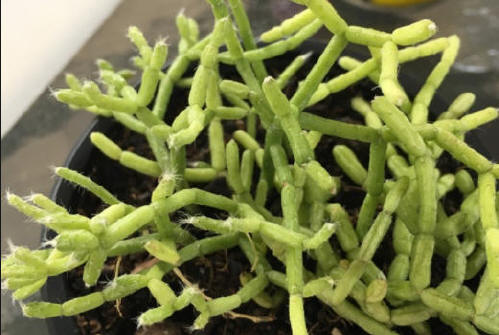 rhipsalis cereuscula
Rhipsalis mistletoe cactus is also
called chain cactus and grows epiphytically in its tropical forest
home.
The cactus has pencil thin succulent stems that may reach 6 feet
in length. The thick skin of the stems does not produce thorns,
but it does have almost imperceptible bumps on the surface of the
plant. These plants are found clinging to tree crotches, in branch
nooks and nestled in rock crevasses. The Rhipsalis mistletoe
cactus is easy to grow and has very minimal needs. It is perfect
for the home interior in a northern or western window. Mistletoe
Cactus Mistletoe cacti are easy to grow from cuttings. Seeds take
way too long and they require very even environmental conditions.
Take cuttings and let the severed end callus for a few days. Plant
the callused end in a cactus mix or sand that has been lightly
moistened. Cuttings root in two to six weeks. The plant rarely
needs fertilizing and has few other needs except moderate light
and even moisture. Fertilize with a half dilution of cactus food
from April to September, once per month. Water frequently in
spring and summer, but suspend water in winter. If any of the
stems are damaged, you can trim them off with a sharp, sterile
knife. Use these as cuttings to start new Rhipsalis mistletoe
cactus.
|
|
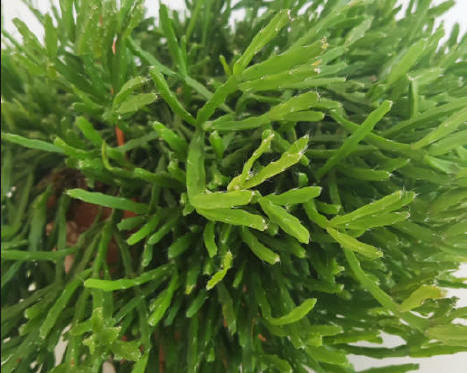 rhipsalis ewaldiana
Mistletoe Cactus Plant
An interesting cactus houseplant, mistletoe cactus is a modern
indoor plant that has a unique form thanks to its trailing shape.
A lush, full-grown plant looks like a living Cousin It --- making
it a fun addition to your indoor decor as well as a conversation
piece.
Because mistletoe cactus has trailing stems, you usually see this
houseplant sold in hanging baskets. They're a great way to enliven
a window.
Grow mistletoe cactus in low to medium light. It can take a little
direct sun indoors, especially in Northern climates, but doesn't
need bright sun to thrive. This indoor plant thrives under
artificial lighting, too.
Unlike most cacti, mistletoe cactus comes from tropical
rainforests rather than the desert. It typically grows on trees
rather than in soil. Because of that, it's best to treat your
mistletoe cactus a bit like an orchid and allow the potting mix to
dry a bit before watering again. Take care not to overwater
mistletoe cactus. If you want to fertilize your mistletoe cactus,
do so in spring and summer using a general-purpose houseplant
fertilizer.
This modern indoor plant also prefers average to high humidity, so
it's an excellent choice for growing in well-lit kitchens and
bathrooms.
|
| |
|
|
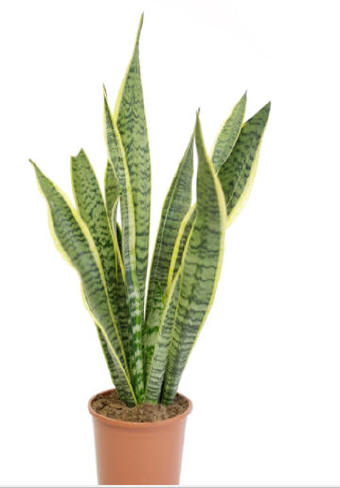 Sansevieria ehrenbergii
Sansevieria is a genus of about 70 species
of flowering plants, native to Africa, Madagascar and southern
Asia.
Common names include mother-in-law's tongue, devil's tongue,
jinn's tongue, bow string hemp, snake plant and snake tongue.
It is often included in the genus Dracaena; tropical plants
such as Sansevieria trifasciata. Plants often form dense clumps
from a spreading rhizome or stolons. The leaves of Sansevieria are
typically arranged in a rosette around the growing point,
The flowers are usually greenish-white, also rose, lilac-red,
Sansevieria can be propagated by seed, leaf cutting, and division.
Seeds are rarely used, as plants can normally be grown much faster
from cuttings or divisions. they do not come true to type
from leaf cuttings, and therefore must be propagated by rhizome
division to retain the variegation. |
|


Sedum is a large genus of flowering plants
in the family Crassulaceae, members of which are commonly known as
stonecrops. The genus has been described as containing up to 600
species
They are leaf succulents found primarily in the Northern
Hemisphere, but extending into the southern hemisphere in Africa
and South America. The plants vary from annual and creeping herbs
to shrubs. The plants have water-storing leaves. The flowers
usually have five petals, seldom four or six. There are typically
twice as many stamens as petals.
Well-known European species of Sedum are Sedum acre, Sedum album,
Sedum dasyphyllum, Sedum reflexum (also known as Sedum rupestre)
and Sedum hispanicum.
|
|
 Sedum adolphii
commonly known as golden sedum, is a succulent perennial.
Sedum adolphii is a species in the genus Sedum which contains
approximately 395 to 759 species and belongs to the family of the
Crassulaceae (Stonecrop Family). The type species of the genus is
Sedum acre.
The perennials reach heights of 10 to 20 centimetres.
Sedum adolphii is evergreen. The moss-green, simple leaves are in
rosettes. white five-stellate flowers from March to April.
Sedum adolphii is native to Mexico.
The perennials prefer a sunny situation on fresh to moist soil.
The substrate should be gritty loam. They tolerate temperatures
down to -7°C Under glass use loamy potting compost with added
gravel.
In summer the plants prefer good ventilation. suited for
cultivation in a temperate house. Suited for rockeries.
For healthy growth apply a compound fertilizer at 50%
concentration monthly during growth.
Water moderately in summer, give little water in winter.
Cuttings in early summer
Division in spring
|
|
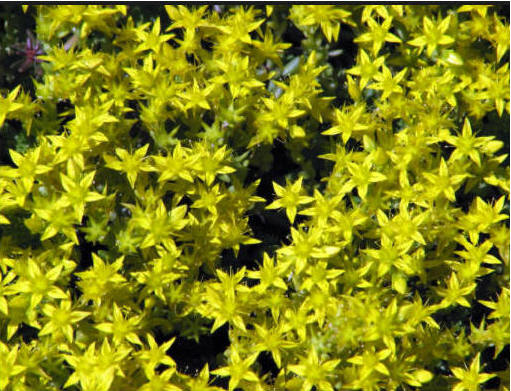
Sedum acre
commonly known as the goldmoss stonecrop,
mossy stonecrop, goldmoss sedum,
biting stonecrop, and wallpepper,
is a perennial flowering plant in the familyCrassulaceae.
It is native to Europe,
but also naturalised in North
America, Japan and New
Zealand.
It is specially adapted for growing on
thin dry soils and can be found on shingle, beaches, drystone walls,
dry banks, seashore rocks, roadside verges, wasteland and in sandy
meadows near the sea
stonecrop spreads
when allowed to do so, but is easily controlled, being
shallow-rooted. It is used in hanging baskets and container
gardens, as a trailing accent, in borders, or as groundcover
It grows well in poor soils, sand, rock gardens, and rich
garden soil, under a variety of light levels. However, it does not
thrive in dense shade with limited water. very hardy
|
| |
|
|
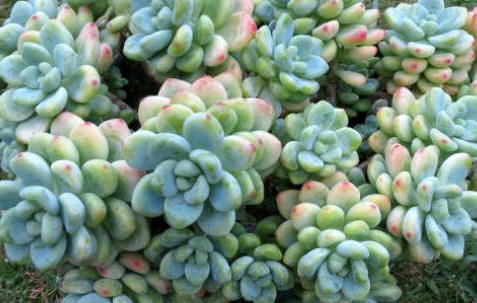 Sedum clavatum
is a succulent plant that grows in compact rosettes that elongate
into long stems with time.
Originally identified growing in southern Mexico, S.clavatum
produces white, star-shaped flowers in mid to late spring to early
summer.
They are often grown as decorative plants in rock gardens. Like
almost all succulents, S. clavatum needs to be protected from
frost and is hardy to 32 °F (0 °C). It grows 4 to 6 inches tall at
mature height and 8 inches wide.
S. clavatum is an annual that needs average watering and is
categorized as fairly easy to maintain. well-draining soil and 4–6
hours of sunlight. Plants should be watered when the soil is dry
but over-watering is to be avoided.
|
|
 Sedum reflexum
or Sedum rupestre,
also known as reflexed stonecrop, blue
stonecrop, Jenny's stonecrop, stone orpine and
prick-madam, is a species of perennial succulent plant of the
genus Sedum, native to northern, central, and southwesternEurope. |
| |
|

Sedum spathulifolium
is a species of flowering plant in the
stonecrop family known by the common name broadleaf stonecrop. It
is native to western North
America from British
Columbia to
southern California,
where it can be found in many types of rocky habitat in coastal
and inland hills and mountains.
This plant is useful as ornamental
groundcover, and tolerates light shade Numerous cultivars have
been selected for garden use, of which 'Cape Blanco'
has gained the Royal Horticultural Society's Award of Garden
Merit
|
| |
|
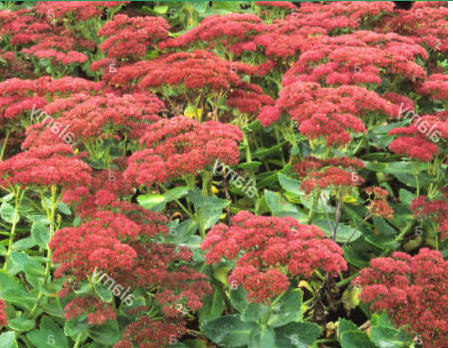
Sedum spectabile
An essential late-summer pit stop for bees
and butterflies. Sedum flowers are little pools of nectar, held on
big, flat, easily accessible flowers where butterflies can rest
and bask in late-summer sun. Green buds look good from midsummer,
then colour pink into autumn. Stems are succulent and frosted,
hence the common name "ice plant".
A sunny position in soil that is not too
rich, even verging on the malnourished. The succulent stems cope
well with dry positions.
|
| |
|
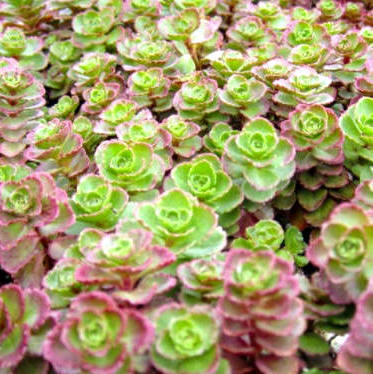
Sedum spurium red form
The creeping selections of Stonecrop are
excellent groundcover plants, particularly for hot, dry sites with
poor soil. This variety forms a low carpet of small, bronzy green
to beet-red leaves, spreading to form a thick patch. Clusters of
ruby-red star flowers appear in summer. A fast grower, this is
best kept away from slower alpine plants that it might smother.
Also a good choice for tubs and mixed containers. Easy to
propagate; simply break pieces off in early summer and stick them
in the ground. Deciduous; trim stems and dead flower heads back in
early spring. Shade tolerant.
|
| |
|
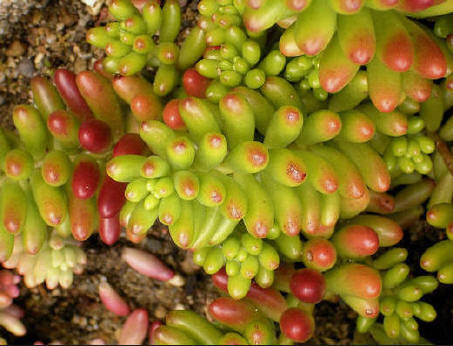 Sedum rubrotinctum
or Sedum × rubrotinctum, and commonly
known as jelly-beans, jelly bean plant, or pork and beans. It is a
species of Sedum from the Crassulaceae family of plants.
Nicknamed for its short leaves that resemble jelly beans,
especially when taking on a protective hue. The plant was named
officially as a distinct species in 1948. It is a succulent plant
originating in Mexico.
The leaves of the Sedum rubrotinctum plant change colour from
green to red during the summer months as a protective adaptation
They sprout bright yellow flowers from between the leaves in
mid-spring.
Sedum rubrotinctum is cultivated as an ornamental plant, for
planting in gardens and as potted plants. It is grown very easily
and tolerates all types of soil except for those that are poorly
drained. It grows very well in summer, can take variations in
climate, although it is not frost-tolerant.
New plants may be grown from leaves (or beans) that drop off or
are separated from the stem and laid on the soil.
Sedum rubrotinctum is poisonous and may cause irritation when
ingested or touched.[ |
| |
|
 Sedum
morganianum
(donkey tail or burro's tail ) is a
species of flowering plant in the family Crassulaceae, native to
southern Mexico and Honduras. It is a succulent perennial
producing trailing stems up to 60 cm (24 in) long, with fleshy
blue-green leaves and terminal pink to red flowers in summer
With a minimum temperature of 5–7 °C (41–45 °F), in temperate
regions S. morganianum is often cultivated as a houseplant in a
suspended container, where the trailing stems hang vertically.
This plant has gained the Royal Horticultural Society's Award of
Garden Merit.
Sedum morganianum grows well outside or indoors, in very good
light or full sun but not extreme heat. Plants are best grown in
full sunlight for strong growth and to enhance leaf coloration. It
requires regular, moderate watering all year, except in winter,
when it should be infrequently watered. Excess water can damage
the plant in a short time. The species is susceptible to
over-watering, especially during winter dormancy. tender
Plants are usually propagated by stem or leaf cuttings. The leaves
are quite delicate and will readily break off the stem when
manipulated. The leaves will stay alive for many days and roots
will emerge after a few days |
| |
|

Sedum decumbens
(Sedum kimnachii)
from Mexico (Northern America).
M The
Mexican sedum, Sedum kimnachii, is an
outstanding succulent species that forms a flat, dense carpet of
rounded glossy chartreuse leaves when grown in good soil with
water; when deprived of a rich growing environment, the foliage
takes on brilliant orange tones, especially in the winter.
Numerous golden-yellow, slightly scented, flowers appear in
clusters in spring to early summer, year after year.
often forming dense low mounds up to 1 metres across It is
evergreen so it doesn't lose its succulent thick leaves through
the winter.
Flowers: 15–50, star shaped, orange-yellow, almost
scentless or slightly perfumed
|
| |
|
|
 Sedum nussbaumerianum
is a species of plant native to Mexico.
Today it can also be found in Italy and on the Canary islands.
Also called stonecrop, or Coppertone Sedum, it is a member of the
Crassulaceae family
These copper toned succulents grow up to 20 cm, and can bloom with
small star shaped white flowers. with full or part sun. They can
be used in rock gardens. Grow from cuttings in summer or seeds in
autumn.
"This plant was first discovered by Carl Albert Purpus at a sulfur
spring in a ravine at Zacualpan in Veracruz, Mexico in 1906 or
1907 but was later described in 1923 by the German botanist Bitter
who named it for Ernst Nussbaumer, the head gardener at the Bremen
Botanic Garden in Germany.
|
| |
|
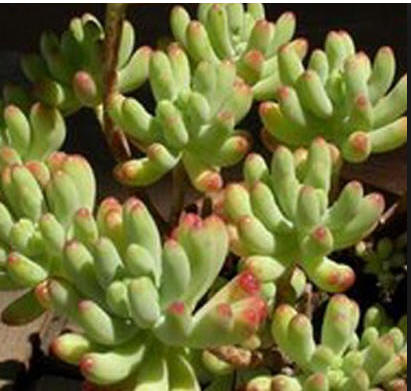
 |
Sedum pachyphyllum Rose
|
Many
Fingers, Succulents Water Plant, Blue Jelly Bean, Silver Jelly
Beans, Succulent Beans, Stonecrop, Jelly Bean Plant
Sedum pachyphyllum is a
small perennial bush forming or ground-hugging succulent up to
30 cm tall, with light silvery green, jelly, bean-like leaves
along short stems. It spreads over time by rooting stems and
fallen leaves that easily take root to form a dense ground
cover. It may become very straggly with age. Young plants may be
quite compact and will flower, when they are quite small. ln
spring large sprays of bigger than usual, widely expanding
starry blossoms in buttercup yellow, adorn the plant, with
petals long and tapered, as are the carpels, stamens and stigma
lobes.
: Woody at base, much branched, upright at first, but
later curved and trailing. Up to 5-30(-50) cm long, but usually
less and are bare in the lower half. In time of drought the
stems carry only a small terminal cluster of leaves.
Short, thick, finger-like to club shaped, standing almost at
right angles to the stem upward curved 1 to 4 cm. long, 6 to 10
mm in cross section. They are grey or light green with a
glaucous-bluish bloom. Leaf tips usually turn red in winter when
kept dry or in sun.
|
| |
|
|
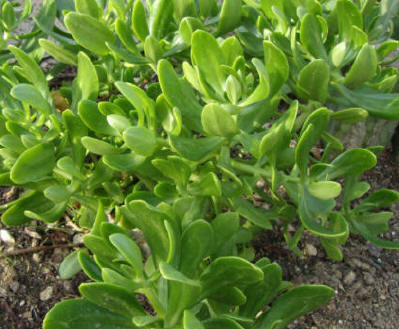 Sedum praealtum
Green Cockscomb
Sedum dendroideum subsp. praealtum, Sedum praealtum subsp.
praealtum
Sedum praealtum is a tall, tree-like succulent plant. It can form
a shrub up to 3 feet (90 cm) in height. Spatulate leaves are shiny
lime green, often with red margins in bright light. The flowers
are star-shaped and yellow in color.
When growing Sedum, keep in mind that Sedum plants need very
little attention or care. They will thrive in conditions that many
other plants thrive in, but will do just as well in less
hospitable areas.
A common name for Sedum is Stonecrop, due to the fact that many
gardeners joke that only stones need less care and live longer.
Sedum is easily planted. For shorter varieties, simply laying the
plant on the ground where you want it to grow is normally enough
to get the Sedum plant started there. They will send out roots
from wherever the stem is touching the ground and root itself. If
you would like to further ensure that the plant will start there,
you can add a very thin covering of soil over the plant. For
taller Sedum varieties, you can break off one of the stems and
push it into the ground where you would like to grow it.
Origin
Native to Mexico.
|
| |
|
 .
Sedum spurium
Easily grown in average, dry to medium
moisture, well-drained soils in full sun. Tolerates some light
shade. Likes sandy or gravelly soils. Needs good soil drainage
to perform well. Drought tolerant. Avoid overwatering. Plants
may be sited 12” apart when grown as a ground cover. Easily
propagated by cuttings or division. Plants are evergreen in warm
winter climates. Unlike some Sedum cultivars, ‘Red
Carpet’ may be grown from seed.
very hardy |
| |
|
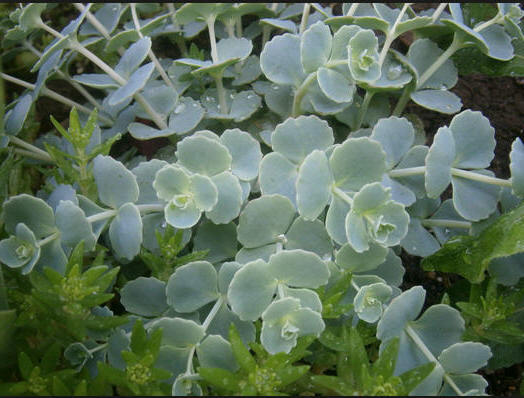 Sedum
sieboldii
is an excellent groundcover plant,
particularly for hot, dry sites with poor soil. This variety forms
a flat, dense mound of blue green leaves. Clusters of pink flowers
appear in late summer. Sedum sieboldii is well suited for the rock
garden or edging in a dry border, also a good choice for
containers.
hardy
perennial deciduous
full Sun is best. |
| |
|
|
 Sedum rupestre
This is a vigorous, mat-forming evergreen species with small gray-green
leaves and terminal clusters of star-shaped, vibrant yellow
flowers in summer. The drooping buds face upward when they open.
It grows to 4 inches tall and 2 feet across.
Give this freely spreading plant room to grow; it makes a great
groundcover and spills over walls.
Provide well-drained, gravelly soil in full sun. It can also take
a bit of shade.
Take stem cuttings or root leaves in early summer; start seed in
atume divide in spring.
problems
Mealybugs, scale, slugs, and snails.
Tolerance : Frost Tolerant
Light : Full Sun to Partial Shade
Maintenance : Low
Plant Height : Under 6 inches
Flower Color : Yellow
|
| |
|
| |
